Mills' Store in Brookton NY
After moving to Mott’s Corners in Mar 1879, Edward restarted his general store next to the Shurter House, where his surviving children Jonas and Emily clerked. Emily took over the store after Edward’s death and operated it under the name M. E. Mills from 1909 until her death in 1937. Soon thereafter, Jessie Brewer took over the store and ran it under her name for a dozen years, primarily as a notions store with a lending library in the back. In 1961, Charles Vorhis purchased the building and moved the post office there from what is presently known as Brookton’s Market. The Mills’ store structure survives today and is located at 484 Brooktondale Road, better known to current residents as “The Old Post Office”.
"...known as the "Store Property" on the southerly side of the highway, which is now and for a considerable time last past has been used and occupied by Miss Mills as a store."
A summary of Mills’ store deeds that I have been able to discover:
| Book | Book num | Page num | Document date | Recorded date | Grantor | Grantee |
|---|---|---|---|---|---|---|
| Caroline Deeds | 1 | 556 | 16 May 1868 | 02 Jun 1868 | Willis Shurter | George E. Sanders |
| Caroline Deeds | 3 | 234 | 12 Oct 1874 | 19 Jan 1875 | George E. Sanders | Edward Lounsbery |
| Deeds | 161 | 540 | 11 Mar 1904 | 02 Dec 1904 | Edward Lounsbery | Amanda S. Lounsbery |
| Deeds | 206 | 236 | 29 Dec 1904 | 03 Mar 1925 | Last Will and Testament of Amanda S. Lounsbery | |
| Deeds | 208 | 353 | 05 May 1925 | 16 May 1925 | Libbie S. Peck | Benjamin F. Lockwood |
| Deeds | 235 | 84 | 03 Jul 1934 | 05 Jul 1934 | Mittie A. Lockwood et al. | Lewis Brewer and Jessie Brewer |
| Deeds | 433 | 637 | 19 Jan 1961 | 20 Jan 1961 | Lewis Brewer and Jessie Brewer | Charles Vorhis |
| Deeds | 499 | 981 | 27 Apr 1972 | 08 May 1972 | Charles C. Vorhis | Frank P. Proto and Almita Ann Proto |
— 484 Brooktondale Road, Brooktondale NY, Tompkins County Clerk, Ithaca NY. Click column headers to change sort order. Download source data.
In the 1866 Photographic Atlas of Tompkins County by Stone & Stewart, a map of Mott’s Corners shows a structure labeled “J. Shurter Store” in the same approximate location as Mills’ Store.

— 1866, Photographic Atlas of Tompkins County, New York. Stone & Stewart, Philadelphia, p21. View largest available size.
Josiah Shurter (26 Apr 1815 to 05 Aug 1877) married Jane (Shutt) Shurter (21 Nov 1825 to 23 Jun 1897). The land that starts just west of the lower bridge in Brooktondale and encompasses the area between the southern side of Brooktondale Road and Six Mile Creek, extending many acres westward, is referenced in the deed records of the Tompkins County Clerk as the Josiah Shurter Homestead.
(Josiah and Jane Shurter were active in the local temperance movement. For more information on this, see High Bridge Lodge No. 296 of The Independent Order of Good Templars, Brookton NY.)
Although Josiah is not listed in the directory below the Stone & Stewart map, the first entry, “E. C. Marsh…Grocery and Provision Store” is almost certainly a reference to the J. Shurter Store. Edward C. Marsh (23 Nov 1836 to 25 Jun 1907) is Josiah Shurter’s son-in-law, and presumably Josiah’s employee. As indicated in the 1865 New York State Census for Caroline, Edward and his wife Harriet (Shurter) Marsh were living in the home of Josiah Shurter. Both Josiah and Edward Marsh are identified as millers, as the Shurter family also owned the lower grist mill at that time. (See Caroline Deeds Book 1, p516, Willis Shurter and Jane his wife to Jacob Vandemark for $5000. The deed is dated 16 Dec 1867, but is recorded 22 Dec 1868.)

— 26 Jun 1865, New York State Census, Caroline NY, p34, ancestry.com. View largest available size.
(It is Edward C. Marsh who appears to have carved his name into the foundation of Mills’ Home at 475 Brooktondale Road.)
By the late 1860’s, Josiah Shurter’s properties were taken over by his son, Willis Shurter (1840 to 17 Jan 1914). On 16 May 1868, “Willis Shurter and Jane Shurter his wife” sell the store property to George E. Sanders (16 Aug 1847 to 01 Nov 1889), and two years later in the 1870 United States Federal Census for Caroline, George E. Sanders is listed in the census as “clerk in store” while George’s father, George Townley Sanders (14 Nov 1818 to 04 May 1887) is listed as a “dealer in dry goods & groceries (ret)”, in his son’s building.
| Year | Edward C. Marsh | George T. Sanders | George E. Sanders |
|---|---|---|---|
| 1850 | (child) | farmer | (child) |
| 1865 | miller | farmer | (child) |
| 1870 | carpenter | dealer in dry goods & groceries (ret) | clerk in store |
| 1875 | carpenter | merchant | tanner |
| 1880 | laborer | retired merchant | farmer |
– Occupations from United States Federal Census and New York State Census, Caroline NY, ancestry.com.
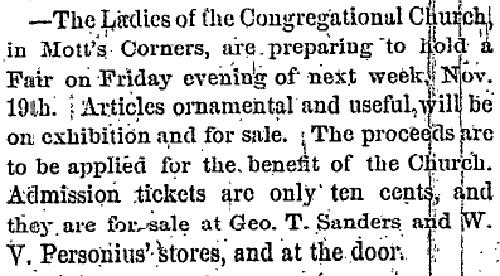
– The Ladies of the Congregational Church, in Mott’s Corners, are preparing to hold a Fair on Friday evening of next week, Nov. 19th. Articles ornamental and useful, will be on exhibition and for sale. The proceeds are to be applied for the benefit of the Church. Admission tickets are only ten cents, and they are for sale at Geo. T. Sanders and W. V. Personius’ stores, and at the door.
— 09 Nov 1869, Ithaca Journal, Ithaca NY, p1, nyshistoricnewspapers.org. View largest available size.
Former merchants here were George T. Sanders and John J. Bush. Stores are kept at present by Frank F. Mulks and E. M. Mills. Frank F. Mulks is postmaster.
— 1894, Landmarks of Tompkins County, New York Including a History of Cornell University by Prof. W.T. Hewitt, edited by John H. Selkreg, D. Mason & Company, Syracuse NY, p291.
George T. Sanders married Lurana Maria “Maria” (Nicholas) Sanders (30 Oct 1820 to 13 Jan 1884), and they, along with daughter and son-in-law, Amanda (Sanders) and Edward Lounsbery, were founding members of the Congregational Church of Mott’s Corners in 1868. Interestingly, George T. Sanders was Brookton postmaster from 20 Jul 1861 to 15 Dec 1864, succeeded by Walker V. Personius. The postoffice was always closely associated with one of the general stores, which was a common custom in America at the time, especially in smaller communities. George T.’s tenure as postmaster could suggest that he worked in and possibly managed the store before his son purchased the building, just as he did for several years after his son sold it, but it could also suggest the possibility that George T. Sanders previously worked at Walker V. Personius’ store, also known as “Mott’s original store” at present day 559 Brooktondale Road.
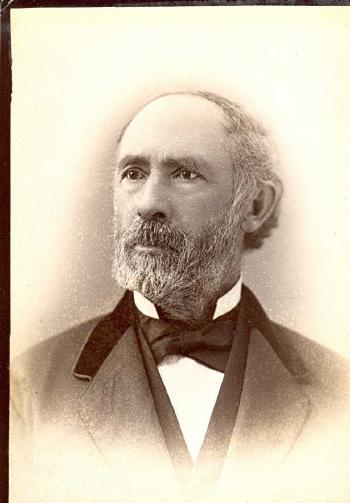
— George Townley Sanders. From a family collection uploaded to Ancestry.com by J. Burbank, reproduced here with permission, Identity confirmed by J. Burbank, personal correspondence. View largest available size.

— Maria Sanders. From a family collection uploaded to Ancestry.com by J. Burbank, reproduced here with permission, Identity confirmed by J. Burbank, personal correspondence. Cropped. View largest available size.
COOPER-SANDERS HOUSE, left – 65 White Church Road
In 1850, S. Cooper lived here, but by 1866 this was the home of George T. Sanders (1818-1887) and his wife L. Maria Nicholas (1820-1884).
– A Drive-by Tour of the Town of Caroline sponsored by the Town of Caroline Bicentennial Committee 1994-1995, Tour 3 - P6.
On 12 Oct 1874, “George E. Sanders and Fannie his wife” (Frances “Fannie” (Webster) Sanders (23 Nov 1847 to 10 Feb 1896)) sell the store property to George’s brother-in-law, Edward Lounsbery (11 Oct 1833 to 27 Nov 1904), and a few months later in the 1875 census, George E. Sanders’ occupation is “tanner” presumably working with Edward: when Franklin Cuthbert Cornell Sr. (28 Aug 1837 to 22 Jan 1908), the eldest son of Ezra Cornell (11 Jan 1807 to 09 Dec 1874), the founder of Cornell University, sold the upper grist mill property to George Campbell, Caroline Deeds book 3, page 550, 21 May 1881, a “piece of land” was reserved for Edward and his brother-in-law, George E. Sanders (16 Aug 1847 to 01 Nov 1889), which seems to corroborate a Carl English painting displayed in the Caroline History Room that refers to a tannery near the upper mill, although the deeds only refer to it as a “factory”. George E.’s obituary states that he was also a produce dealer at one time.
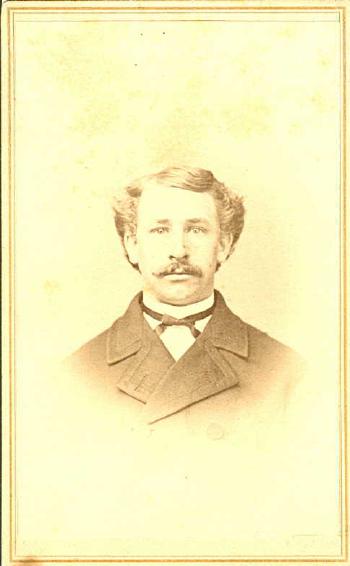
— George E. Sanders. From a family collection uploaded to Ancestry.com by J. Burbank, reproduced here with permission, Identity confirmed by J. Burbank, personal correspondence. View largest available size.

— George E. Sanders. From a family collection uploaded to Ancestry.com by J. Burbank, reproduced here with permission, Identity confirmed by J. Burbank, personal correspondence. View largest available size.
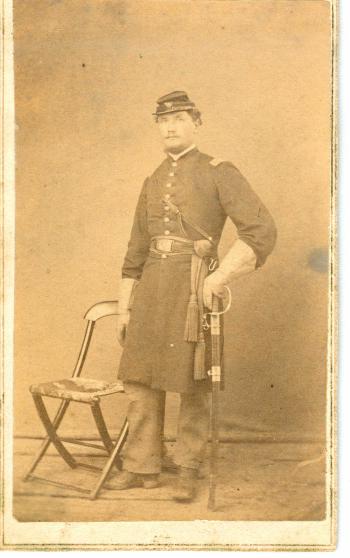
— Edward Lounsbery. From a family collection uploaded to Ancestry.com by J. Burbank, reproduced here with permission, Identity confirmed by J. Burbank, personal correspondence. View largest available size.
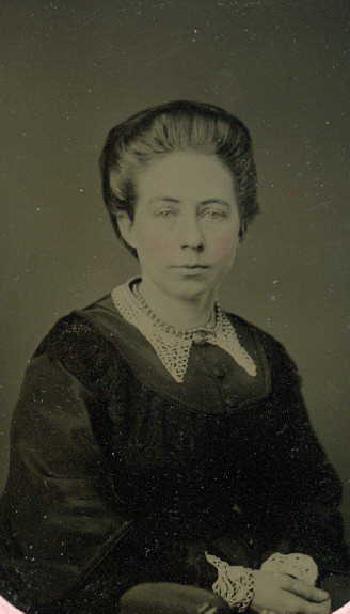
— Amanda Lounsbery. From a family collection uploaded to Ancestry.com by J. Burbank, reproduced here with permission, Identity confirmed by J. Burbank, personal correspondence. View largest available size.
It appears George E.’s father George T. Sanders continues to operate the store for several years the transfer from his son to his son-in-law, as evidenced by the following news item discussing the temperance group High Bridge Lodge No. 296 of The Independent Order of Good Templars, Brookton NY, of which George T. Sanders’ family, including daughter Amanda (Sanders) Lounsbery (12 Oct 1842 to 13 Nov 1921) and her husband Edward, were members.
This Lodge will for the present meet on Monday evening in “Lounsberry [sic] Hall” over the store of Mr. Sanders, who by the way, with his family are members of the Order.
– 14 Mar 1876, The Dryden Herald, Dryden NY, fultonhistory.com.
A few years later in March 1879, Edward Mills arrives in Mott’s Corners and takes over operation of the store shortly thereafter. The following news item from Mott’s Corners, approximately nine months after the Mills family arrived, describes a “firm of Mills & Co.”, and I believe this is likely an early reference to Edward’s business, and if true, it would seem to indicate that Edward still had co-owners, possibly still including Charles M. Pine and James A. Hillyer, who were his partners in the Corfu store. By the 1890’s the store was referenced simply as “E. H. Mills”, and informally called “Mills’ Store”. (Charles Pine was financially ruined by his son Alverade in early 1891 and he died in 1897.)
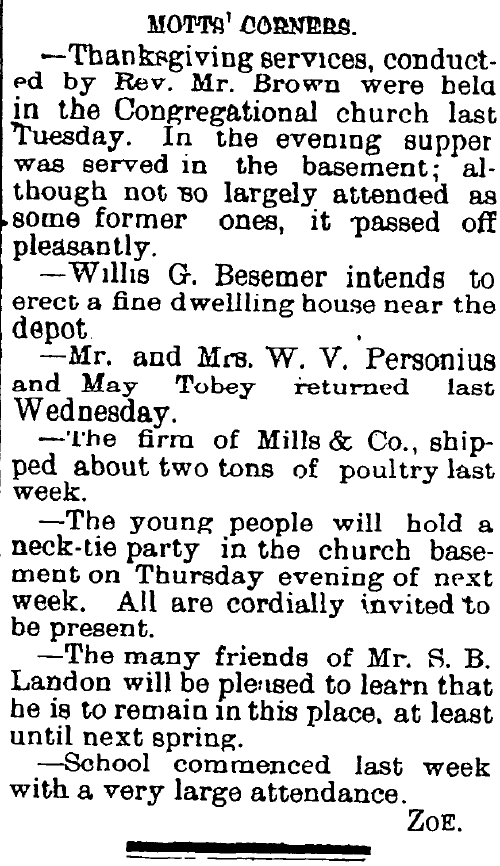
MOTTS’ CORNERS.
—Thanksgiving services, conducted by Rev. Mr. Brown were held in the Congregational church last Tuesday. In the evening supper was served in the basement; although not so largely attended as some former ones, it passed off pleasantly.
—Willis G. Besemer intends to erect a fine dwellling house near the depot.
—Mr. and Mrs. W. V. Personius and May Tobey returned last Wednesday.
—The firm of Mills & Co., shipped about two tons of poultry last week.
—The young people will hold a neck-tie party in the church basement on Thursday evening of next week. All are cordially invited to be present.
—The many friends of Mr. S. B. Landon will be pleased to learn that he is to remain in this place, at least until next spring.
—School commenced last week with a very large attendance.
Zoe.
— 03 Dec 1879, Ithaca Daily Journal, Ithaca NY, p4, nyshistoricnewspapers.org. View largest available size.
I haven’t yet found another reference to this firm, and presumably if a reference could be found prior to the Mills’ move to Mott’s Corners, that fact would presumably rule out a connection to the Mills family. But I will also note that in the 1880 Caroline census, I do not see anyone else with the last name Mills. So, although I cannot directly link this firm to Edward H. Mills, I am inclined to believe, based on the circumstantial evidence, that this firm is likely Edward Mills’, and if true, this could provide an important clue to not only their first months Mott’s Corners, but it could also possibly point to the reason why they chose to move to Mott’s Corners specifically.
(I have also considered the possibility that this is a misspelling of a similar name, such as “Mulks”, “Miles” or perhaps even “Miller”. There is also a farmer in Caroline with the name Gills. I will also note that in January 1875, there is a “new Ithaca poultry journal, to be called ‘The Poultry Organ’” (02 Jan 1875, Ithaca Daily Journal, Ithaca NY, p4). I have not found this publication yet, but it may provide more context.)
The 1880 United States Federal Census for Caroline shows Edward is a “merchant” and his son Jonas is a “clerk in store”.
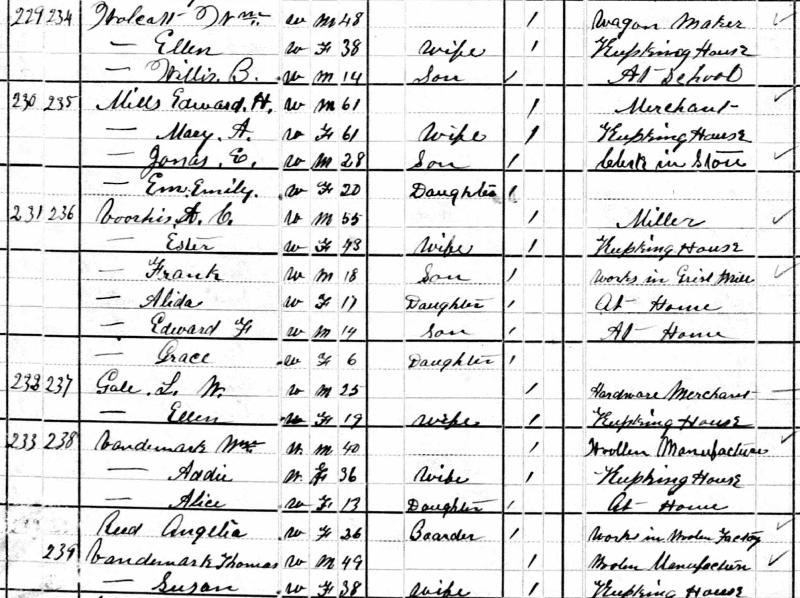
— 15 Jun 1880, United States Federal Census, Caroline NY, p21, ancestry.com. View largest available size.
Correspondingly in 1880, George T. Sanders and wife Maria are living in Cortland with their daughter Sarah F. (Sanders) Edwards (09 Oct 1840 to 10 May 1896), who married Nelson G. Edwards (01 Aug 1835 to 21 Nov 1920). George T. listed his occupation as “retired merchant”, and he lived the rest of his life in Cortland.

— 12 Jun 1880, United States Federal Census, Cortland NY, p23. View largest available size.
Edward Mills’ surviving children Jonas and Emily clerk in their father’s store, and they also both become members of High Bridge Lodge shortly after arriving in Mott’s Corners. Mills’ store is indirectly mentioned in the High Bridge Lodge meeting minutes notebook On 20 Feb 1885: “Worthy Chief and two girls retired to the store for refreshments.” (Tompkins County History Center, Ithaca NY.)
One of George E. Sanders later activities:

Some of our farmers are drawing their potatoes to George Saunders [sic] at Caroline Depot, for forty cents per bushel.
— 10 Feb 1887, Ithaca Daily Journal, Ithaca NY, p3, nyshistoricnewspapers.org. View largest available size.
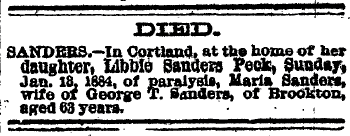
DIED.
SANDERS.–In Cortland, at the home of her daughter, Libbie Sanders Peck, Sunday Jan. 18, 1884, of paralysis, Maria Sanders, wife of George T. Sanders, of Brookton, aged 63 years.
— 05 Feb 1884, Ithaca Daily Journal, Ithaca NY, p3, nyshistoricnewspapers.org. View largest available size.
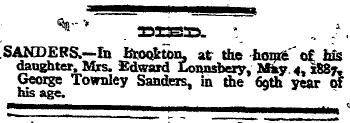
DIED.
SANDERS.–In Brookton, at the home of his daughter, Mrs. Edward Lonnsbery [sic], May 4, 1887, George Townley Sanders, in the 69th year of his age.
— 18 May 1887, Ithaca Daily Journal, Ithaca NY, p3, nyshistoricnewspapers.org. View largest available size.
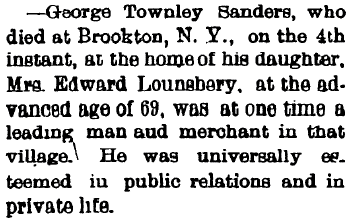
—George Townley Sanders, who died at Brookton, N. Y., on the 4th instant, at the home of his daughter, Mrs. Edward Lounsbery, at the advanced age of 69, was at one time a leading man and merchant in that village. He was universally esteemed in public relations and in private life.
— 10 May 1887, Ithaca Daily Journal, Ithaca NY, p3, nyshistoricnewspapers.org. View largest available size.
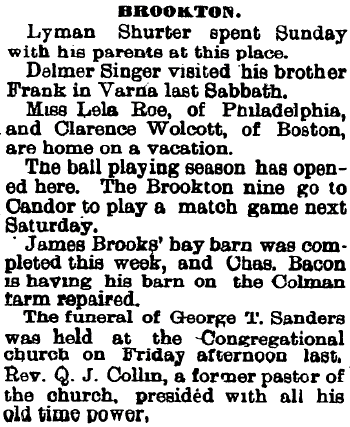
BROOKTON.
Lyman Shurter spent Sunday with his parents at this place.
Delmer Singer visited his brother Frank in Varna last Sabbath.
Miss Lela Roe, of Philadelphia, and Clarence Wolcott, of Boston, are home on a vacation.
The ball playing season has opened here. The Brookton nine go to Candor to play a match game next Saturday.
James Brooks’ bay barn was completed this week, and Chas. Bacon is having his barn on the Colman farm repaired.
The funeral of George T. Sanders was held at the Congregational church on Friday afternoon last, Rey. Q. J. Collin, a former pastor of the church, presided with all his old time power.
— 13 May 1887, Ithaca Daily Journal, Ithaca NY, p3, nyshistoricnewspapers.org. View largest available size.
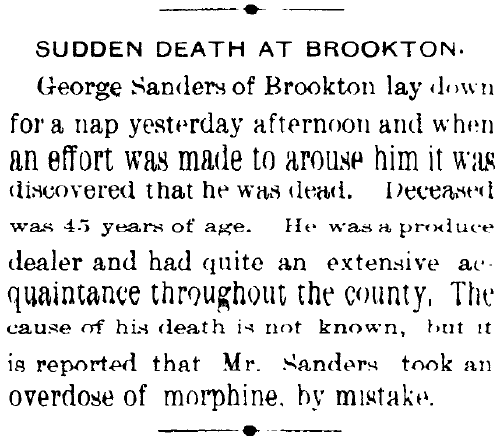
SUDDEN DEATH AT BROOKTON.
George Sanders of Brookton lay down for a nap yesterday afternoon and when an effort was made to arouse him it was discovered that he was dead. Deceased was 45 years of age. He was a produce dealer and had quite an extensive acquaintance throughout the county. The cause of his death is not known, but it is reported that Mr. Sanders took an overdose of morphine, by mistake.
— 02 Nov 1889, Ithaca Daily Journal, Ithaca NY, p3, nyshistoricnewspapers.org. View largest available size.
More information on the activities of the Sanders and Lounsbery families can be found at:
- Founding the Congregational Church
- High Bridge Lodge No. 296 of The Independent Order of Good Templars, Brookton NY
- Deeds and Other Past Owners
Mills’ store, Summer 2021:

— 07 Aug 2021, Adam Smith. View largest available size.
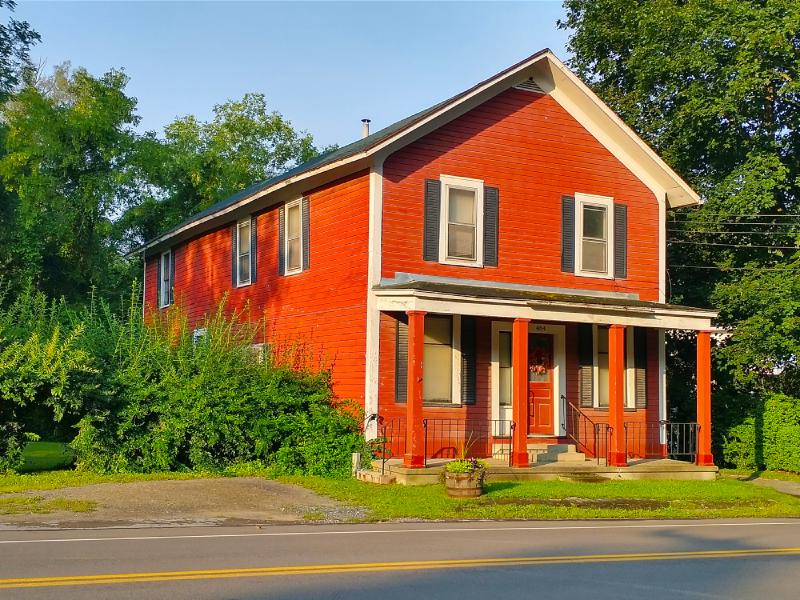
— 07 Aug 2021, Adam Smith. View largest available size.
Long-time community members call this building “The Old Post Office” referring to when it was used as such starting in 1961 under postmaster Charles Vorhis. But the post office had also been in that building many years prior, moving there when Edward Mills became postmaster.
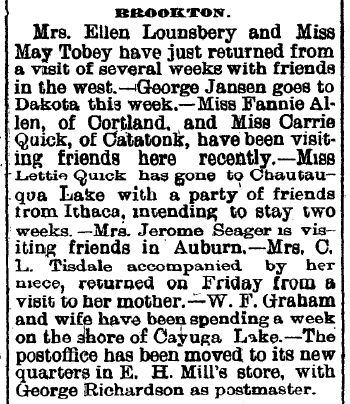
BROOKTON.
Mrs. Ellen Lounsbery and Miss May Tobey have just returned from a visit of several weeks with friends in the west. –George Jansen goes to Dakota this week. –Miss Fannie Allen, of Cortland, and Miss Carrie Quick, of Catatonk, have been visiting friends here recently. –Miss Lettie Quick has gone to Chautauqua Lake with a party of friends from Ithaca, intending to stay two weeks. –Mrs. Jerome Seager is visiting friends in Auburn. –Mrs. C. L. Tisdale accompanied by her niece, returned on Friday from a visit to her mother. –W. F. Graham and wife have been spending a week on the shore of Cayuga Lake. –The postoffice has been moved to its new quarters in E. H. Mill’s store, with George Richardson as postmaster.
— 13 Aug 1885, Ithaca Daily Journal, Ithaca NY, p3, nyshistoricnewspapers.org. View largest available size.
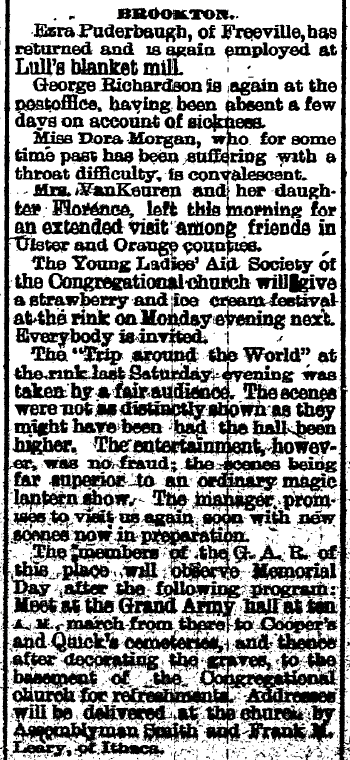
BROOKTON.
Ezra Puderbaugh, of Freeville, has returned and is again employed at Lull’s blanket mill.
George Richardson is again at the postoffice, having been absent a few days on account of sickness.
Miss Dora Morgan, who for some time past has been suffering with a throat difficulty, is convalescent.
Mrs. VanKeuren and her daughter Florence, left this morning for an extended visit among friends in Ulster and Orange counties.
The Young Ladies’ Aid Society of the Congregational church will give a strawberry and ice cream festival at the rink on Monday evening next. Everybody is invited.
The “Trip around the World” at the rink last Saturday evening was taken by a fair audience. The scenes were not as distinctly shown as they might have been had the hall been higher. The entertainment, however, was no fraud; the scenes being far superior to an ordinary magic lantern show. The manager promises to visit us again soon with new scenes now in preparation.
The members of the G. A. R. of this place will observe Memorial Day after the following program: Meet at the Grand Army hall at ten A. M., march from there to Cooper’s and Quick’s cemeteries, and thence after decorating the graves, to the basement of the Congregational church for refreshments. Addresses will be delivered at the church by Assemblyman Smith and Frank M. Leary, of Ithaca.
— 27 May 1887, Ithaca Daily Journal, Ithaca NY, p3, nyshistoricnewspapers.org. View largest available size.
It appears George H. Richardson (May 1862 to 26 Feb 1938) was an employee of Edward’s, as he is never identified as the official postmaster in the USPS records. George also appears to be yet another person who was mentored in the grocery business and eventually began his own store.
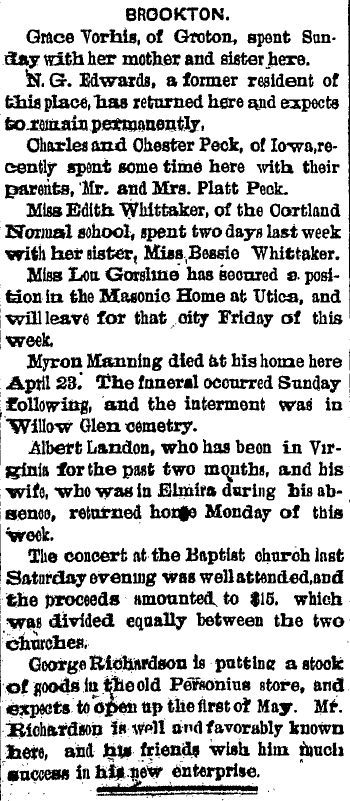
BROOKTON.
Grace Vorhis, of Groton, spent Sunday with her mother and sister here.
N.G. Edwards, a former resident of this place, has returned here and expects to remain permanently.
Charles and Chester Peck, of Iowa, recently spent some time here with their parents, Mr. and Mrs. Platt Peck.
Miss Edith Whittaker, of the Cortland Normal school, spent two days last week with her sister, Miss Bessie Whittaker.
Miss Lou Gorsline has secured a position in the Masonic Home at Utica, and will leave for that city Friday of this week.
Myron Manning died at his home here April 23. The funeral occurred Sunday Following, and the interment wad in Willow Glen cemetery.
Albert Landon, who has been in Virginia for the past two months, and his wife, who was in Elmira during his absence, returned home Monday of this week.
The concert at the Baptist church last Saturday evening was well attended, and the proceeds amounted to $15, which was divided equally between the two churches.
George Richardson is putting a stock of goods in the old Personius store, and expects to open up the first of May. Mr. Richardson is well and favorably known here, and his friends wish him much success in his new enterprise.
— 01 May 1897, Ithaca Daily Journal, Ithaca NY, p8, nyshistoricnewspapers.org. View largest available size.
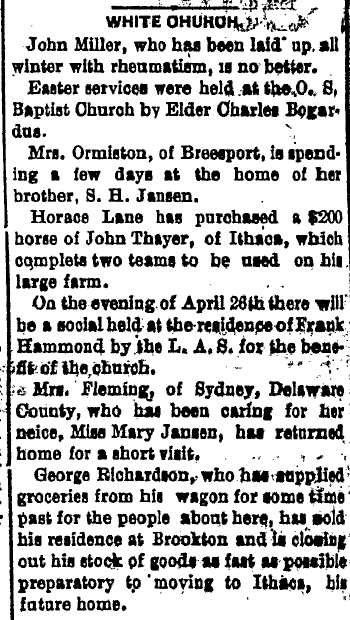
WHITE CHURCH
John Miller, who has been laid up all winter with rheumatiem, is no better.
Easter services were held at the 0. S. Baptist Church by Elder Dharles Bogardus.
Mra. Ormiston, of Breesport, is spending a few days at the home of her brother, S. H. Jansen.
Horace Lane has purchased a $200 horse of John Thayer, of Ithaca, which camplete two teams to be used on his large farm.
On the evening of April 28th there will be a social held at the residence of Frank Hammond by the L. A. S. for the benefit of the church.
Mrs. Fleming, of Sydney, Delaware County, who bas been caring for her neice, Misa Mary Jansen, has returned home for a short visit,
George Richardson, who has supplied groceries from his wagon for some time past for the people about here, has sold his residence at Brookton and is closing out his stock of goods as fast as possible preparatory to moving to Ithaca, his future home.
— 26 Apr 1905, Ithaca Daily Journal, Ithaca NY, p5, nyshistoricnewspapers.org. View largest available size.
A section of this site is devoted to George Richardson’s time in Brookton. Edward’s page has more information on his time as postmaster, including examples of his postmark on envelopes from the time.
The following are some of the earliest references to Mills’ store, detailing misadventures that took place while Emily was known to be a “clerk” at the store:

Tompkins County vs. E. H. Mills. Edward N. Burdick for plff. C. R. Wolcott for deft.
— 14 Oct 1896, Ithaca Daily Journal, Ithaca NY, p6, nyhistoricnewspapers.org. View largest available size.
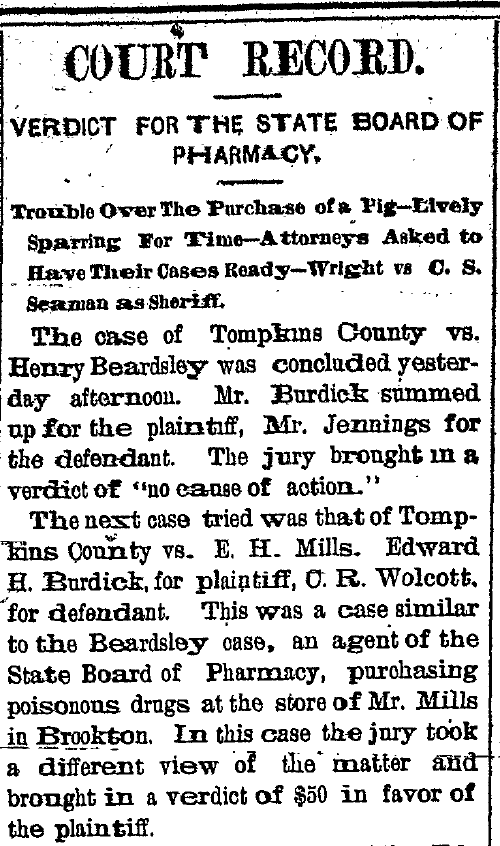
COURT RECORD
VERDICT FOR THE STATE BOARD OF PHARMACY.
… The next case tried was that of Tompkins County vs. E. H. Mills. Edward H. Burdick for plaintiff, C. R. Wolcott for defendant. This was a case similar to the Beardsley case, an agent of the State Board of Pharmacy, purchasing poisonous drugs at the store of Mr. Mills in Brookton. In this case the jury took a different view of the matter and brought in a verdict of $50 in favor of the plaintiff.
— 18 Mar 1897, Ithaca Daily Journal, Ithaca NY, p6, nyshistoricnewspapers.org. View largest available size.
In its Caroline materials, The Tompkins County History Center in Ithaca NY has a reproduction of a newspaper clipping of a poem that is prefaced with: “Written for, and Recited at the Poet’s Entertainment at the Congregational Church, Brookton, Feb. 6, 1897, by Mrs. Ella E. Mandeville.” I cannot find the original citation information. The following three stanzas from Ella’s poem describe Mulk’s general store, the postoffice in the rear of Mulk’s store, and then, E. H. Mills general store, stating that it was “one more of like design” and emphasizing the fairness and honesty of the “obliging, pleasant owners”:
There's a store lately modeled For convenience; partly new, With clean yellow painted surface, Trimmed about with darker hue; Where, arranged upon the counters And the shelves of ample space And in glass cases, Yankee notions, Dry goods, substantials, lace, Trimmings for dress goods, modeled As Dame Fashion last designed, With a host of other features, In its roomy space you find. Pharmaceutics, too, is practiced; School book, boots and shoes are sold; Groceries of all descriptions. Parceled out for standard gold, Or for silver, butter, hen's-eggs, Or for promise of good pay. One may take the goods and use them And can pay some other day. Half-way down its length established, Is a place where, morn and eve, Niece and nephew wait expectant, For what "Uncle Sam" may give. Just across the public highway, Is one more of like design As regards its inner contents, Indicated by the sign. Step within, and look around you. Great variety you find. And obliging, pleasant owners, Ready every want to mind. Years of honest, faithful dealing, Confidence and trust inspire. Weight and measure always honest, All will find their fair dealing there.
— Tompkins County History Center, Ithaca NY. Original citation could not be found."
The following shows that the Mills’ store was involved in charity while Edward was alive:

The Brookside Circle of King’s Daughters are packing a barrel for the Cubans, and anything in the way of food or clothing left at the store of E. H. Mills will be duly forwarded.
— 31 Mar 1898, Ithaca Daily Journal, Ithaca NY, p5, nyhistoricnewspapers.org. View largest available size.
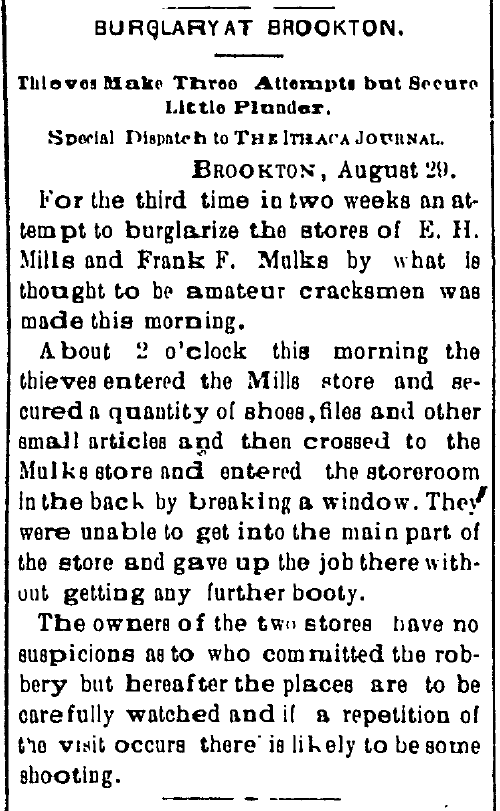
BURGLARY AT BROOKTON
Thieves Make Three Attempts but Secure Little Plunder.
Special Dispatch to The Ithaca Journal.
BROOKTON, August 29.
For the third time in two weeks an attempt to burglarize the stores of E. H. Mills and Frank F. Mulks by what is thought to be amateur cracksmen was made this morning.
About 2 o’clock this morning the thieves entered the Mills store and secured a quantity of shoes, files and other small articles and then crossed to the Mulks store and entered the storeroom in the back by breaking a window. They were unable to get into the main part of the store and gave up the job there without getting any further booty.
The owners of the two stores have no suspicions as to who committed the robbery but hereafter the places are to be carefully watched and if a repetition of the visit occurs there is likely to be some shooting.
— 29 Aug 1904, Ithaca Daily Journal, Ithaca NY, p6, nyshistoricnewspapers.org. View largest available size.
I have seen perhaps more than a dozen volumes of sales journals and other financial record books that are in the possession of a local collector who told me he was contacted by Frank Proto at the time Frank took possession of the former Mills’ store building, and he was given the opportunity to go through the basement of the building and preserve anything of historical value.

— E. H. Mills Store Sales Journal No. 41, digital photograph of book owned by Brooktondale collector. View largest available size.
Interestingly, the oldest of the volumes, labeled “No. 41” is the most important as it shows the records of E. H. Mills in the days immediately preceding Edward’s death. It seems Emily herself (or perhaps Jessie Brewer after her) did not preserve the books from her father’s time running the store.
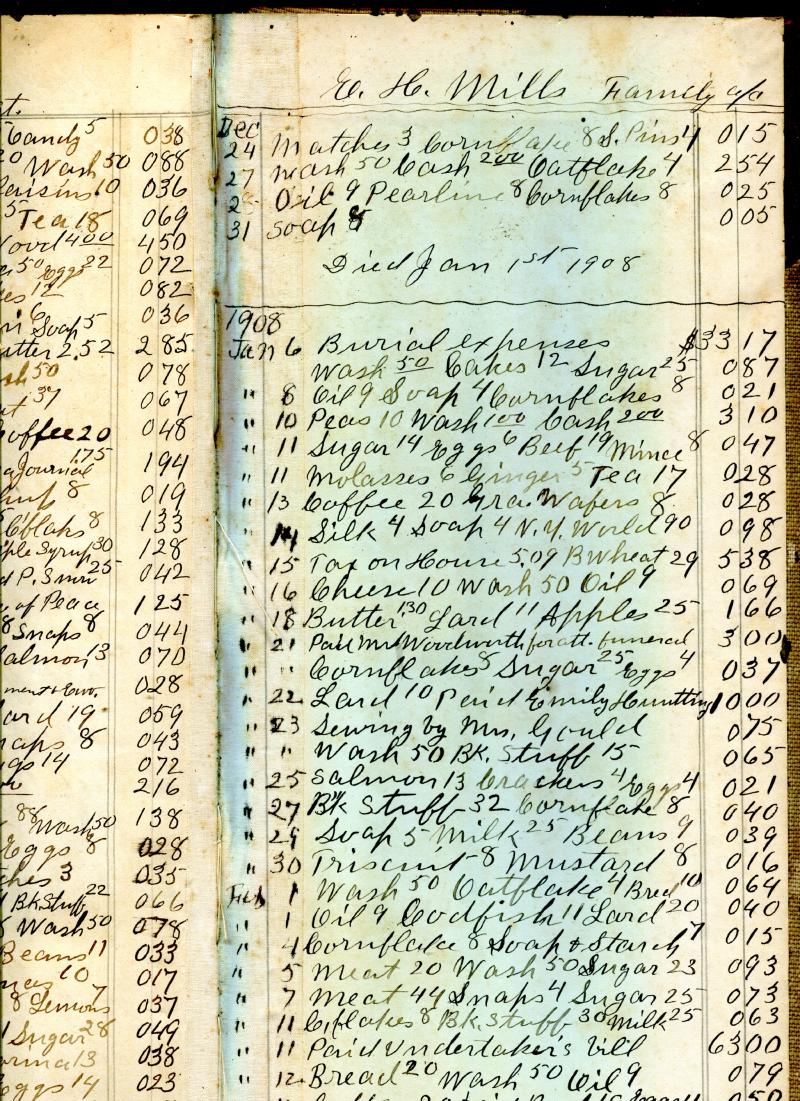
The following are selected transcriptions from the image adapted for this presentation format:
E. H. Mills Family a/c
- Died Jan 1st 1908
- 1908, Jan 6, Burial expenses, $33.17
- 1908, Jan 15, Tax on house 5.09
- 1908, Jan 21, Paid Mr[s?]. Woodworth for att. funeral, $3.00
- 1908, Jan 22, Lard (10) paid Emily Huntting, $10.00
- 1908, Jan 23, Sewing by Mrs. Gould, $0.75
- 1908, Feb 11, Paid Undertaker’s bill, $3.00
— Dec 1907 - Jan 1908, E. H. Mills Family a/c, Mills Store Sales Journal No. 41, scanned image of book owned by Brooktondale collector. View largest available size.
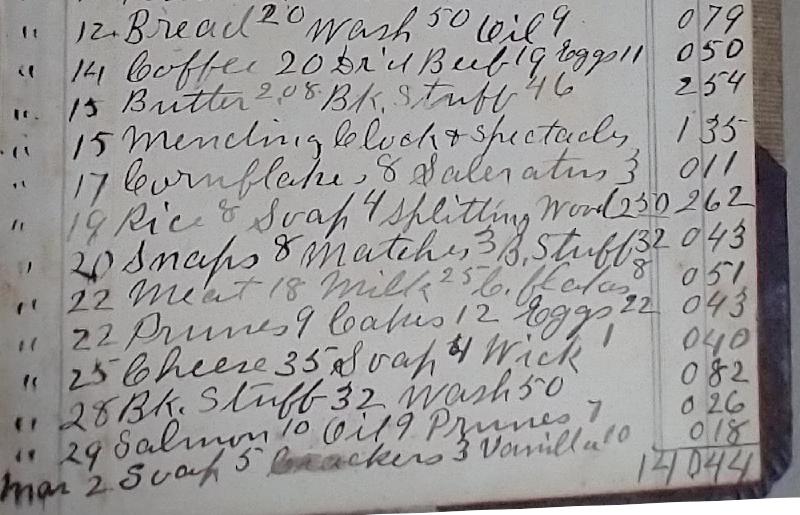
— Dec 1907 to Jan 1908, E. H. Mills Family a/c, Mills Store Sales Journal No. 41, digital photograph of book owned by Brooktondale collector. View largest available size.
The “Mills Family a/c” pages show the Mills’ business expenses, mostly paying for store inventory. In these earlier books, this information was at the end of the book, starting with the inside back cover and progressed toward the front over time, whereas retail sales, including what the family themselves took out of the store, were entered in the books in the normal order, starting from the front and working toward the back.
The Mills Family account in the months following Edward’s death:

The following are selected transcriptions from the image adapted for this presentation format:
- 1908 Mar 12 splitting wood .50 wood 4.00 4.50
- 1908 Mar 12 Goods bought in Ithaca 50
- 1908 Mar 23 Paid for Ithaca Journal 1.75
- 1908 Mar 28 Eggs .14 needles .03 paid P. Snow .25 .42
- 1908 Mar 30 Paid Mitchell as Justice of Peace 1.25
- 1908 Apr 4 Paid D. F. Roe for acknowledgment & E[unclear]. .28
— Mar 1908, E. H. Mills Store Sales Journal No. 41, digital photograph of book owned by Brooktondale collector. View largest available size.
The store was open on New Year’s eve and New Year’s day 1908, the day Edward died, and Emily was working on an otherwise typical day of business at the store:
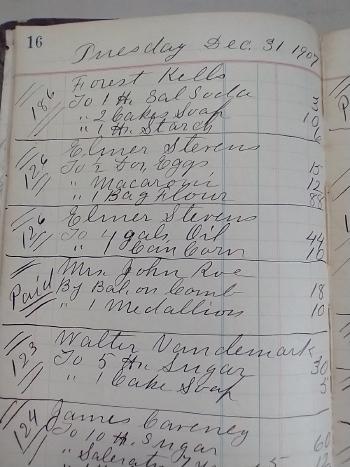
— 31 Dec 1907, E. H. Mills Store Sales Journal No. 41, digital photograph of book owned by Brooktondale collector. View largest available size.
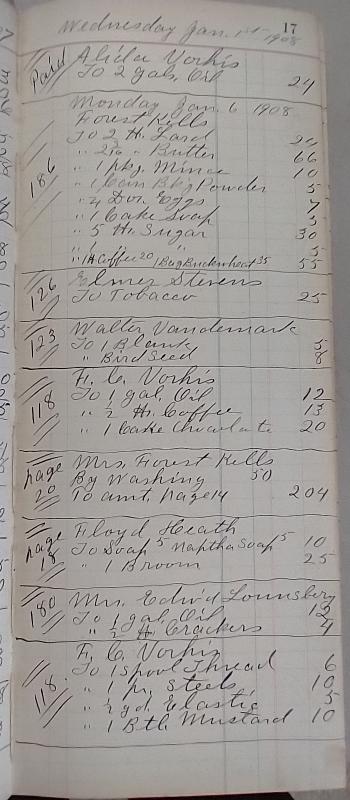
— 01 Jan 1908, E. H. Mills Store Sales Journal No. 41, p17, digital photograph of book owned by Brooktondale collector. View largest available size.
As you look at these sale entries, understand that you are seeing Emily continue a practice that she learned from her father, just as her brothers had learned from him in Corfu, and George Richardson had also learned from him in Brookton. Edward in turn had learned this practice from his older brother-in-law Charles M. Pine in Staten Island, where Charles also taught this practice to James Hillyer, Bartlett Brown, and Charles’ son Theodore, among others.
As you can see, these books contain many easily recognizable names of former Brookton residents, along with their regular purchases. It is interesting to note the store was closed on Sundays, but open on Christmas day, if a bit slow:
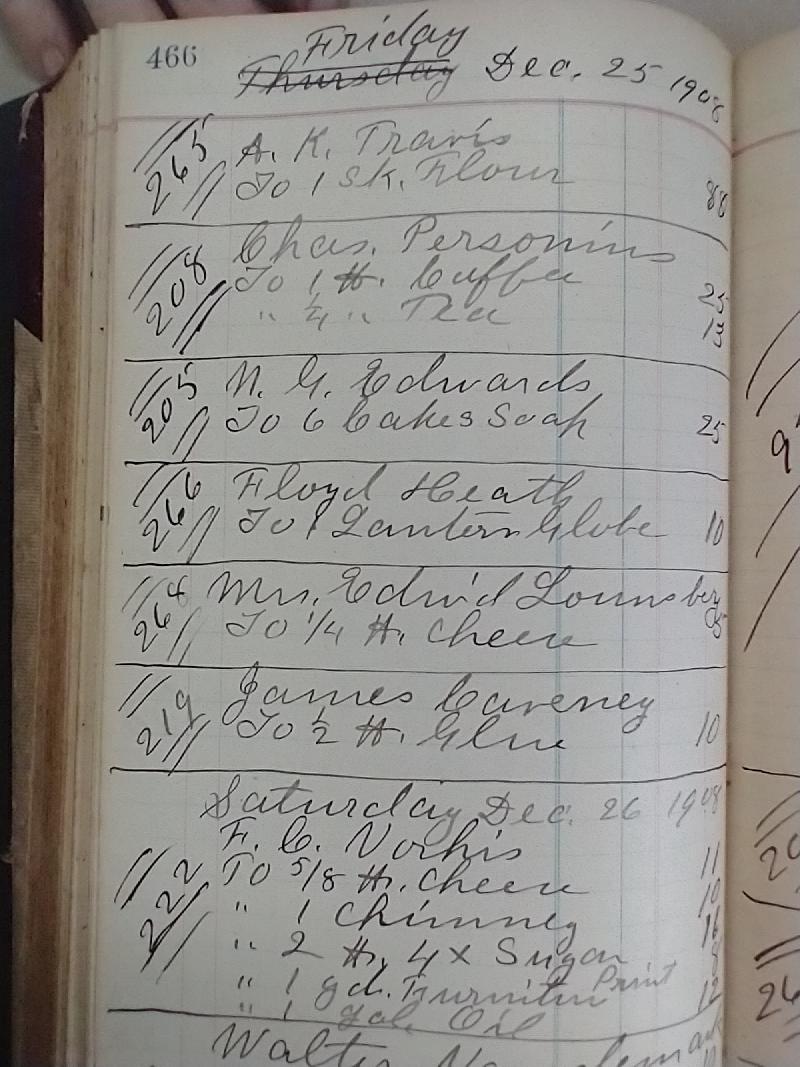
— 25 Dec 1908, E. H. Mills Store Sales Journal No. 41, p466, digital photograph of book owned by Brooktondale collector. View largest available size.
And some examples of Emily’s own entries in the sales logs. Essentially, this is a glimpse inside Emily and Hannah’s pantry. Emily may have had a bit of a sweet tooth, as candy was one of the more common staples:
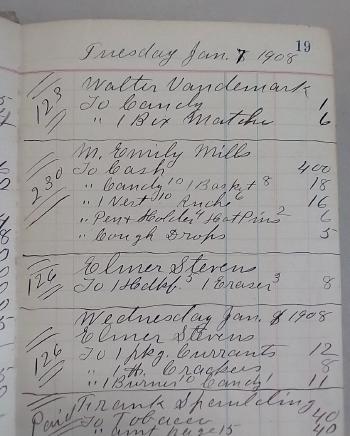
— 07 Jan 1908, E. H. Mills Store Sales Journal No. 41, p19, digital photograph of book owned by Brooktondale collector. View largest available size.
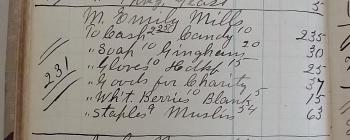
— 26 Mar 1909, E. H. Mills Store Sales Journal No. 41, p554 digital photograph of book owned by Brooktondale collector. View largest available size.
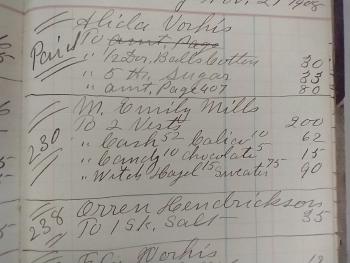
— E. H. Mills Store Sales Journal No. 41, digital photograph of book owned by Brooktondale collector. View largest available size.
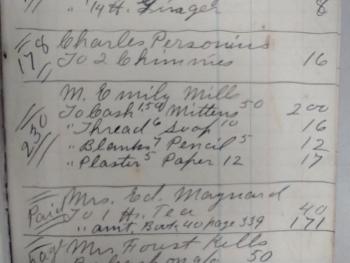
— E. H. Mills Store Sales Journal No. 41, p19, digital photograph of book owned by Brooktondale collector. View largest available size.
By 1920, her daily records looked much the same.
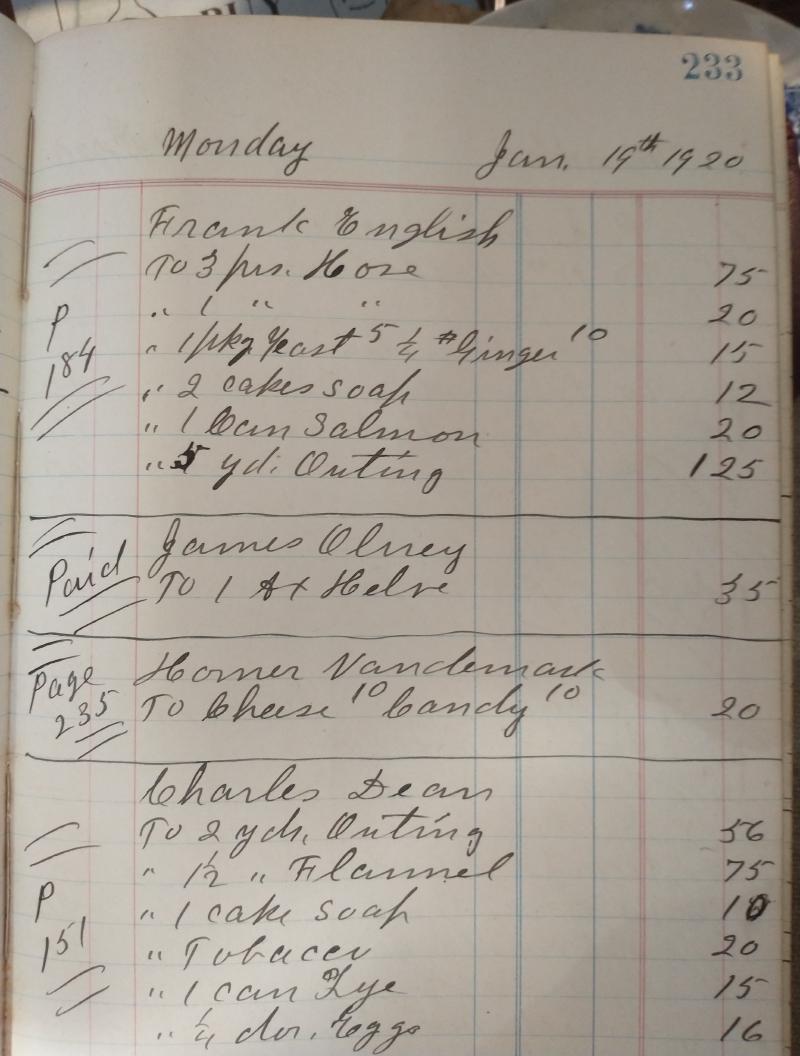
— 19 Jan 1920, M. E. Mills Store Sales Journal, p233, digital photograph of book owned by Brooktondale collector. View largest available size.
In the 1920’s, more sophisticated business records emerge, both new types of records kept as well as a more formal breakdown of the store’s inventory expenditures. These journals contained sample pages and instructions that Emily may have used to teach herself these new methods. This is further indication of Emily’s character and how much pride she took in ownership of her store that she was continually teaching herself new practices, even after decades of daily work in this occupation.
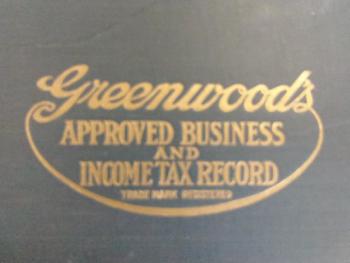
— M. E. Mills Store Sales Records, digital photograph of book owned by Brooktondale collector. View largest available size.

— Feb 1927, Mills Store Sales Journal, p19, digital photograph of book owned by Brooktondale collector. View largest available size.
Several descriptions of M. E. Mills exist, the most complete of which is Gertrude Conant’s:
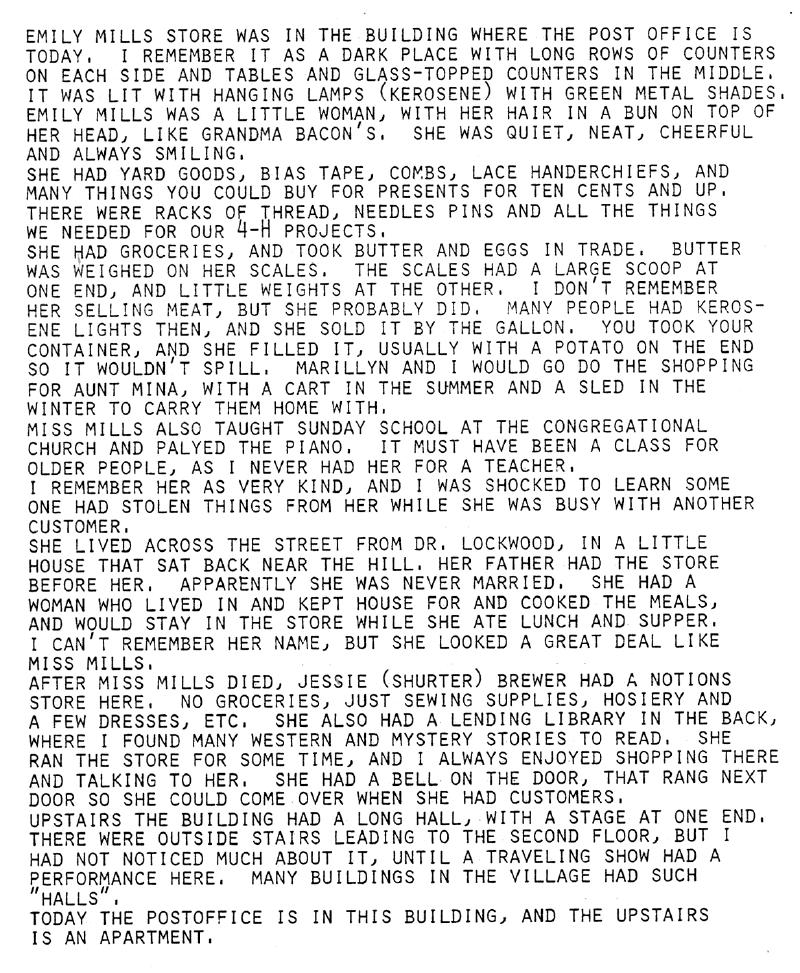
Emily Mills’ store was in the building where the Post Office is today. I remember it as a dark place with long rows of counters on each side and tables and glass-topped counters in the middle. Emily Mills was a little woman, with her hair in a bun on top of her head, like Grandma Bacon’s. She was quiet, neat, cheerful and always smiling.
She had yard goods, bias tape, combs, lace handerchiefs, and many things you could buy for presents for ten cents and up. There were racks of thread, needles, pins and all the things we needed for our 4-H projects.
She had groceries, and took butter and eggs in trade. Butter was weighed on her scales. The scales had a large scoop at one end, and little weights at the other. I don’t remember her selling meat, but she probably did. Many people had kerosene lights then, and she sold it by the gallon. You took your container, and she filled it, usually with a potato on the end so it wouldn’t spill. Marilyn and I would go do the shopping for Aunt Mina, with a cart in the Summer and a sled in the Winter to carry them home with.
Miss Mills also taught Sunday School at the Congregational Church and played the piano. It must have been a class for older people, as I never had her for a teacher.
I remember her as very kind, and I was shocked to learn someone had stolen things from her while she was busy with another customer.
She lived across the street from Dr. Lockwood, in a little house that sat back near the hill. Her father had the store before her. Apparently she never married. She had a woman who lived in and kept house for and cooked the meals, and would stay in the store while she ate lunch and supper. I can’t remember her name, but she looked a great deal like Miss Mills.
After Miss Mills died, Jessie (Shurter) Brewer had a notions store here. No groceries, just sewing supplies, hosiery and a few dresses, etc. She also had a lending library in the back, where I found many western and mystery stories to read. She ran the store for some time, and I always enjoyed shopping there and talking to her. She had a bell on the door, that rang next door so she could come over when she had customers.
Upstairs the building had a long hall, with a stage at one end. There were outside stairs leading to the second floor, but I had not noticed much about it, until a traveling show had a performance here. Many buildings in the village had such “halls”.
Today the Postoffice is in this building and the upstairs is an apartment.
— Gertrude Conant. Used with permission. View largest available size.
In one of the present-day photos of 484 Brooktondale Road, you can see the staircase on the side of building leading to the second floor, that Gertrude mentions. The second floor was known as Lounsbery Hall for owner Edward Lounsbery, who purchased the property on 12 Oct 1874 from George E. Sanders, Edward’s brother-in-law.
Various community groups were known to meet there, including the David Ireland Post of the G.A.R., the Grange, and the High Bridge Lodge of the temperance group, the Good Templars, of which Edward and Amanda Lounsbery, George T. Sanders’ family, George Richardson, William B. Wolcott, and Emily and Jonas Mills were members. (George Richardson and Emily Mills both acted in the locally produced play The Colleen Bawn at Lounsbery Hall as well as several other locations, for the benefit of High Bridge Lodge.
Lounsbery Hall was a popular event venue and community space for years.
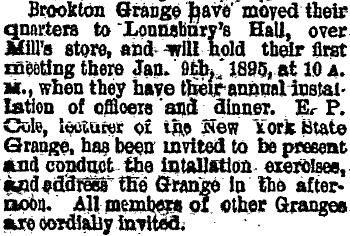
Brookton Grange have moved their quarters to Lounsbury’s [sic] Hall, over Mill’s store, and will hold their first meeting there Jan. 9th, 1895, at 10 A.M., when they have their annual installation of officers and dinner. E. P. Cole, lecturer of the New York State Grange, has been invited to be present and conduct the intallation [sic] exercises, and address the Grange in the afternoon. All members of other Granges are cordially invited.
— 07 Jan 1895, Ithaca Daily Journal, Ithaca NY, p3, nyshistoricnewspapers.org. View largest available size.
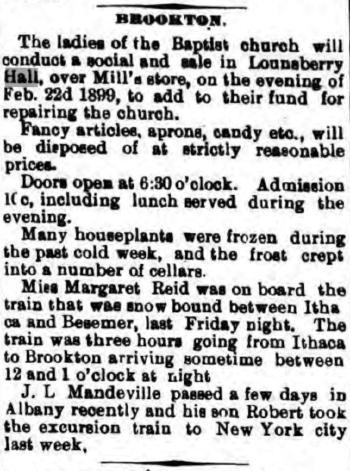
BROOKTON.
The ladies of the Baptist church will conduct a social and sale in Lounsberry Hall, over Mill’s store, on the evening of Feb. 22d 1899, to add to their fund for repairing the church.
Fancy articles, aprons, candy etc., will be disposed of at strictly reasonable prices.
Doors open at 6:30 o’clock. Admission 10c, including lunch served during the evening.
Many houseplants were frozen during the past cold week, and the frost crept into a number of cellars.
Miss Margaret Reid was on board the train that was snow bound between Ithaca and Besemer, last Friday night. The train was three hours going from Ithaca to Brookton arriving sometime between 12 and 1 o’clock at night
J. L Mandeville passed a few days in Albany recently and his son Robert took the excursion train to New York city last week.
— Feb 1899, Ithaca Daily News, Ithaca NY, fultonhistory.com. The page number could not be determined from the source.View largest available size.
The following sections provide greater detail on the activities in Lounsbery Hall, clearly describing the location in earlier years above Sanders’ store, and then Mills’:
- High Bridge Lodge No. 296 of The Independent Order of Good Templars, Brookton NY
- Deeds and Other Past Owners
A Drive-by Tour of the Town of Caroline sponsored by the Town of Caroline Bicentennial Committee 1994-1995, contains a listing for M. E. Mills on a page identified as “Tour 4 - P7” in a 2016 reprint by The White Church Cabin Country Store and appears to be the source (with some alterations) of the description Molly Adams used in her “Note”. In Molly’s research notes, she gives the attribution: “[Driveby, ie Conant]" and I have confirmed with Barbara Kone that Gertrude wrote the Brooktondale portions of the “Drive-by” book:
BROOKTONDALE POST OFFICE, left – 484 Brooktondale Road
This was Miss Mary Emily Mills’(1861-1937) Dry Goods Store. She also had kerosene, Kerosene lamps with green shades, penny candy, stockings, handkerchiefs, yard goods, pins & sewing notions sheets & pillowcases, groceries, etc. She was a “sweet little lady” who succeeded her father in the business. Jessie Brewer had dry goods here after Miss Mills, and also had a lending library in the back.
The post office has moved at least 3 times. This is the 3rd site.Between the Post Office and the bridge sat the Shurter House which was moved.
And Molly Adams, in A Note on Emily Mills further describes Emily’s initial marketing attempts on her own:
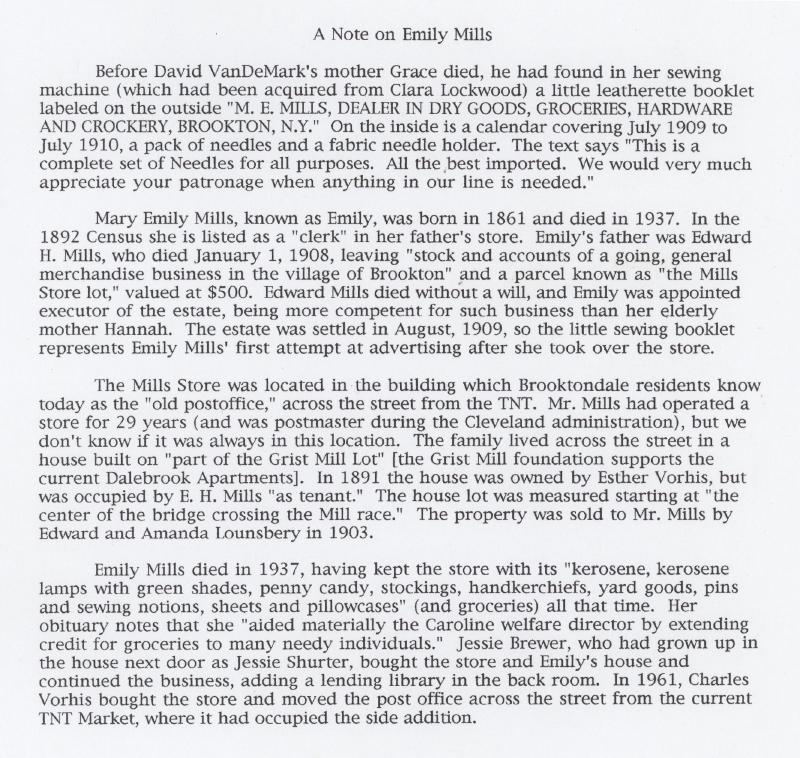
A Note on Emily Mills
Before David VanDeMark’s mother Grace died, he had found in her sewing machine (which had been acquired from Clara Lockwood) a little leatherette booklet labeled on the outside “M. E. MILLS, DEALER IN DRY GOODS, GROCERIES, HARDWARE AND CROCKERY, BROOKTON, N.Y.” On the inside is a calendar covering July 1909 to July 1910, a pack of needles and a fabric needle holder. The text says “This is a complete set of needles for all purposes. All the best imported. We would very much appreciate your patronage when anything in our line is needed.”
Mary Emily Mills, known as Emily, was born in 1861 and died in 1937. In the 1892 Census she is listed as a “clerk” in her father’s store. Emily’s father was Edward H. Mills, who died January 1, 1908, leaving “stock and accounts of a going, general merchandise business in the village of Brookton” and a parcel known as “the Mills Store lot,” valued at $500. Edward Mills died without a will, and Emily was appointed executor of the estate, being more competent for such business than her elderly mother Hannah, The estate was settled in August, 1909, so the little sewing booklet represents Emily Mills’ first attempt at advertising after she took over the store.
The Mills Store was located in the building which Brooktondale residents know today as the “old postoffice,” across the street from the TNT. Mr. Mills had operated a store for 29 years (and was postmaster during the Cleveland administration), but we don’t know if it was always in this location. The family lived across the street in a house built on “part of the Grist Mill Lot” [the Grist Mill foundation supports the current Dalebrook Apartments]. In 1891 the house was owned by Esther Vorhis, but was occupied by E. H. Mills “as tenant.” The house lot was measured starting at “the Center of the bridge crossing the Mill race.” The property was sold to Mr. Mills by Edward and Amanda Lounsbery in 1903.
Emily Mills died in 1937, having kept the store with its “kerosene, kerosene lamps with green shades, penny candy, stockings, handkerchiefs, yard goods, pins and sewing notions, sheets and pillowcases” (and groceries) all that time. Her obituary notes that she “aided materially the Caroline welfare director by extending credit for groceries to many needy individuals.” Jessie Brewer, who had grown up in the house next door as Jessie Shurter, bought the store and Emily’s house and continued the business, adding a lending library in the back room. In 1961, Charles Vorhis bought the store and moved the post office across the street from the current TNT Market, where it had occupied the side addition.
— Molly Adams. View largest available size.
The answer to Molly’s question “and some groceries?” seems to be yes. Perhaps the question arose because Jessie Brewer apparently did not continue to sell groceries, and this was what residents of the time would more likely remember.
Barbara Kone and others have searched the Caroline History Room for the “leatherette booklet” Molly mentioned, but it has not yet been found. Fortunately, Molly had the foresight to keep printed reproductions in her file folders:
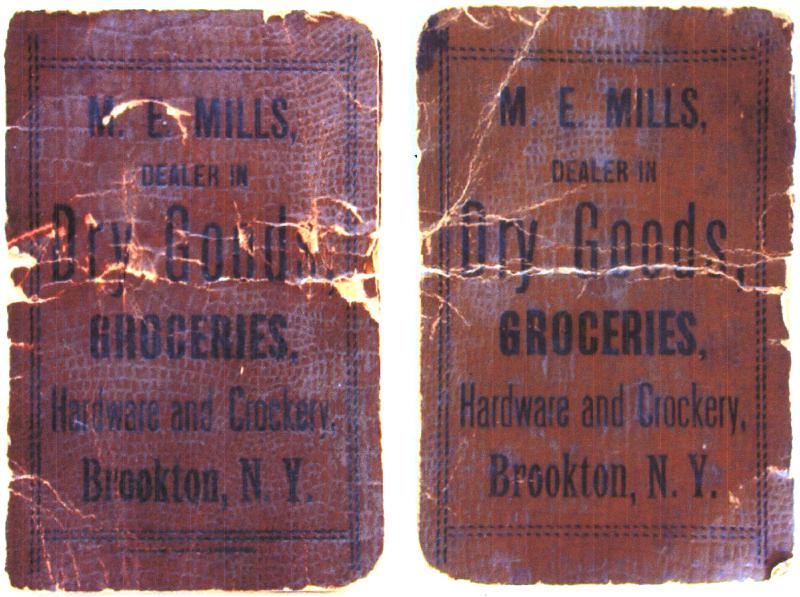
M. E. Mills,
Dealer in
Dry Goods,
Groceries,
Hardware and Crockery,
Brookton, N. Y.
— Molly Adams Collection, Caroline History Room, Slaterville NY. View largest available size.
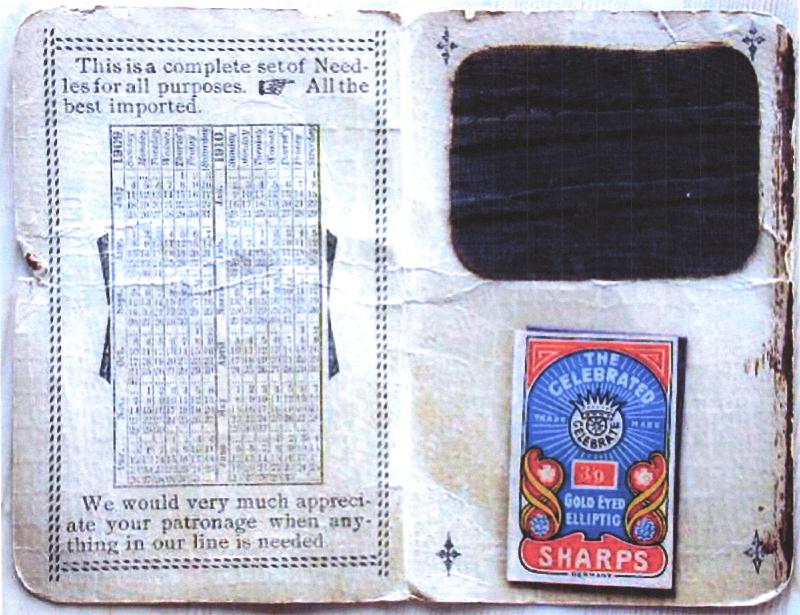
This is a complete set of Needles for all purposes. All The best imported.
[1909 and 1910 calendar]
We would very much appreciate your patronage when anything in our line is needed.
— Molly Adams Collection, Caroline History Room, Slaterville NY. View largest available size.
And Molly retained a printed reproduction of the following item; the location of the original is currently unknown to me:
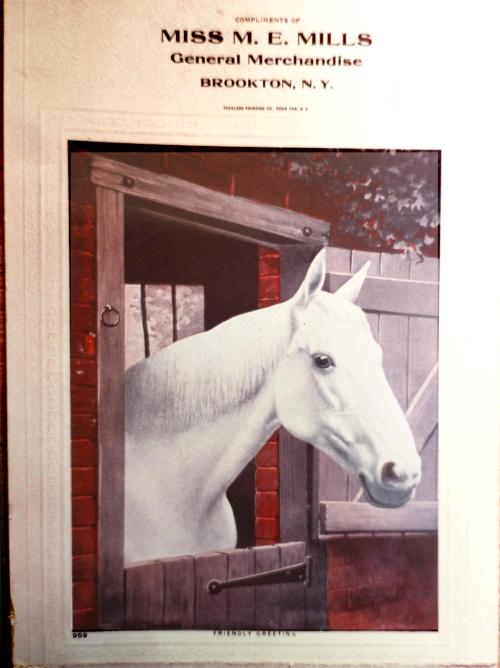
Compliments of
Miss M. E. Mills
General Merchandise
Brookton, N. Y.
Friendly Greeting
— Molly Adams Collection, Caroline History Room, Slaterville NY. View largest available size.
Finally, a few details that Molly preserved in the Mills family folder, including a description of Emily and the cases inside her stores:
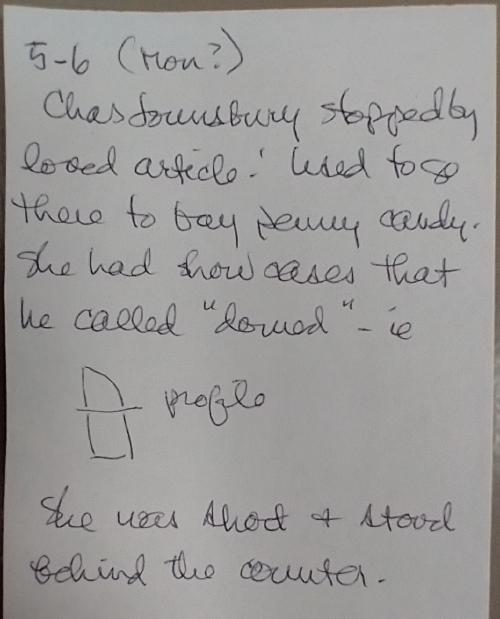
5-6 (Mon?)
Chas Lounsbery stopped by good[?] article! Used to go there to buy penny candy. She had show cases that he called “domed” - ie
[pen drawing] profile
She was short & stood behind the counter.
— Molly Adams Collection, Caroline History Room, Slaterville NY. View largest available size.
As Molly describes in her “Note”, Emily began aggressively advertising the newly branded store in 1909. She advertised perhaps dozens of times in the Ithaca Daily Journal alongside the Vorhis Mill and the meat market that is attributed at one time to Clarence Wheeler, someone mentioned many times in the journals of George Jansen. The first such advertisement I could find was in the 29 Mar 1909 edition (exactly 30 years after the Mills moved to Motts Corners), and the last was on 30 Jun 1910. What follows are a sample of some of them, many of which were repeated for weeks at a time, and they provide a good sense of the diverse products offered in the small country store:

M. E. MILLS
BROOKTON, N.Y.
Carries a good assortment of
Hardware, Groceries, Dry
Goods and Notions
— 29 Mar 1909, Ithaca Daily Journal, Ithaca NY, p9, nyhistoricnewspapers.org. View largest available size.
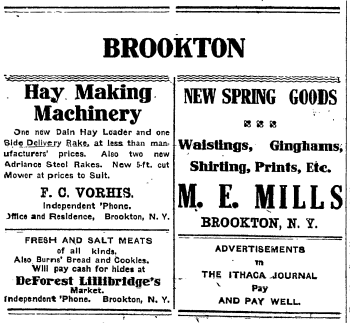
NEW SPRING GOODS
Waistings, Ginghams,
Shirting, Prints, Etc.
M. E. MILLS
BROOKTON, N.Y.
— 02 Jun 1909, Ithaca Daily Journal, Ithaca NY, p9, nyhistoricnewspapers.org. View largest available size.
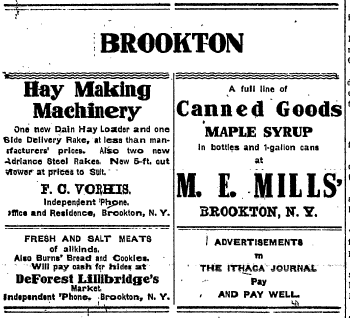
A full line of
Canned Goods
MAPLE SYRUP
In bottles and 1-gallon cans
at
M. E. Mills'
Brookton, N.Y.
— 19 Jun 1909, Ithaca Daily Journal, Ithaca NY, p9, nyhistoricnewspapers.org. View largest available size.
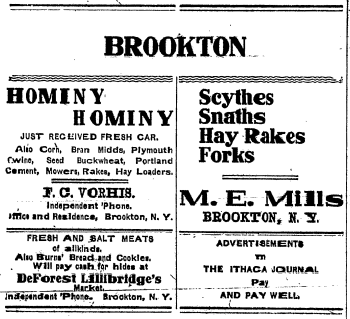
Scythes
Snaths
Hay Rakes
Forks
M. E. Mills
BROOKTON, N.Y.
— 20 Jul 1909, Ithaca Daily Journal, Ithaca NY, p9, nyhistoricnewspapers.org. View largest available size.
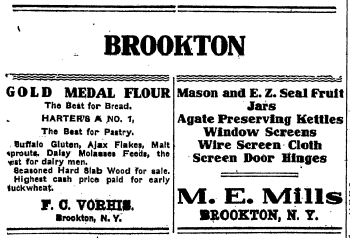
Mason and E. Z. Seal Fruit
Jars
Agate Preserving Kettles
Window Screens
Wire Screen Cloth
Screen Door Hinges
M. E. Mills
BROOKTON, N.Y.
— 05 Oct 1909, Ithaca Daily Journal, Ithaca NY, p9, nyhistoricnewspapers.org. View largest available size.
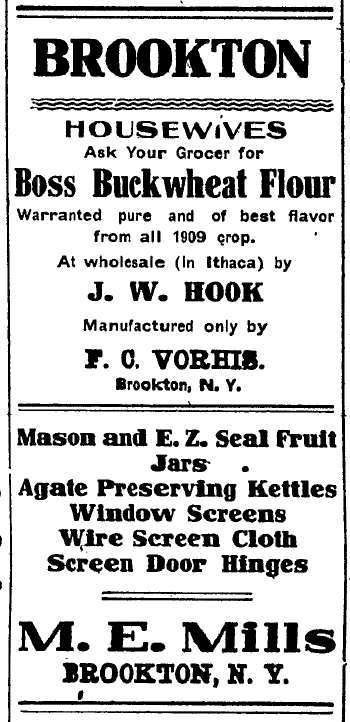
Mason and E. Z. Seal Fruit
Jars
Agate Preserving Kettles
Window Screens
Wire Screen Cloth
Screen Door Hinges
M. E. Mills
BROOKTON, N.Y.
— 13 Oct 1909, Ithaca Daily Journal, Ithaca NY, p9, nyhistoricnewspapers.org. View largest available size.
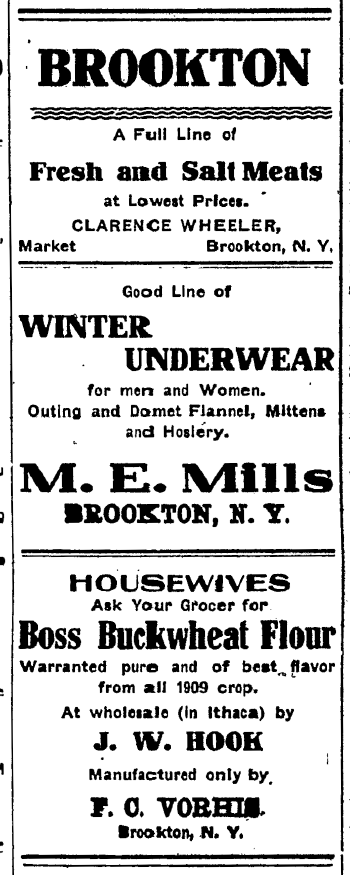
Good Line of
WINTER UNDERWEAR
for men and Women.
Outing and Domet Flannel, Mittens
and Hosiery.
M. E. Mills
BROOKTON, N.Y.
— 04 Nov 1909, Ithaca Daily Journal, Ithaca NY, p9, nyhistoricnewspapers.org. View largest available size.
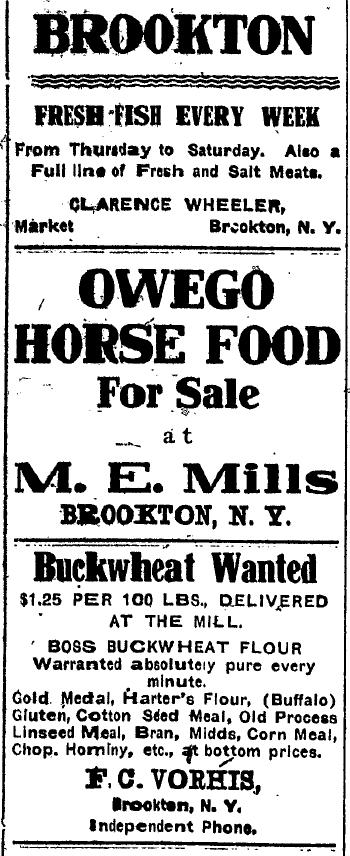
Owego Horse Food
For Sale
at
M. E. Mills
Brookton, N. Y.
— 19 Feb 1910, Ithaca Daily Journal, Ithaca NY, p9, nyshistoricnewspapers.org. View largest available size.
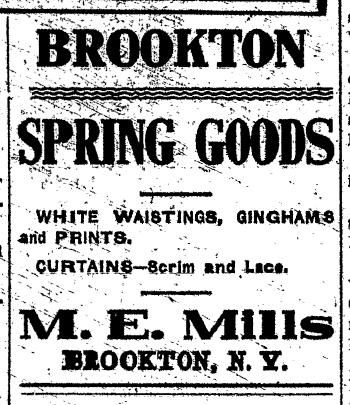
SPRING GOODS
WHITE WAISTINGS, GINGHAMS
and PRINTS.
CURTAINS—Scrim and Lace.
M. E. Mills
BROOKTON, N.Y.
— 30 Jun 1910, Ithaca Daily Journal, Ithaca NY, p9, nyhistoricnewspapers.org. View largest available size.
In the Ithaca Daily Journal, 26 Aug 1909, pg 5, in an article “Early History of Brookton Village” M. E. Mills is listed as a “present merchant”.
We know a great deal about Emily through the activities of M. E. Mills, which Emily made a community focal point as a natural consequence of her many interests and activities, and intentional or not, had to have been excellent marketing for her store. My impressions are that Emily took a great deal of pride in the running of her store and took its effective management very seriously and did indeed consider every opportunity to volunteer her store for free press and increased foot traffic, such as the regular millinery exhibits by Margaret LaBar.
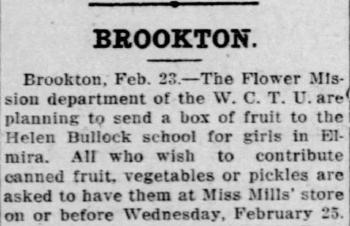
BROOKTON Brookton, Feb. 23—The Flower Mission department of the W. C. T. U. are planning to send a box of fruit to the Hellen Bullock school for girls in Elmira. All who wish to contribute canned fruit, vegetables or pickles are asked to have them at Miss Mills’ store on or before Wednesday, February 25.
— 23 Feb 1914, The Ithaca Journal, Ithaca NY, p9, newspapers.com. View largest available size.
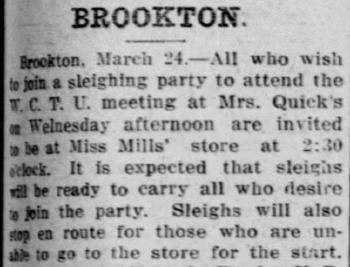
BROOKTON Brookton, March 24—All who wish to join a sleighing party to attend the W. C. T. U. meeting at Mrs. Quick’s on Wednesday afternoon are invited to be at Miss Mills’ store at 2:30 o’clock. It is expected that sleighs will be ready to carry all who desire to join the party. Sleighs will also stop en route for those who are unable to go the store for the start.
— 24 Mar 1914, The Ithaca Journal, Ithaca NY, p9, newspapers.com. View largest available size.

MARGARET LA BARRE will hold a millinery display at Ferguson’s store, Slaterville, Wednesday, October 14th; at Miss Mills’ store, Brookton, Thursday, October 22d. 10-13
— 10 Oct 1914, The Ithaca Journal, Ithaca NY, p10, newspapers.com. View largest available size.

A case containing a pair of spectacles was found in front of the Congregational church a week ago last Saturday. The owner will find them at Miss Emily Mills’ store.
— 23 Oct 1914, The Ithaca Journal, Ithaca NY, p11, newspapers.com. View largest available size.
Hat-making or millinery is the design, manufacture and sale of hats and other headwear. A person engaged in this trade is called a milliner or hatter.
– Hatmaking, Wikipedia.org.
Miss Margaret “Maggie” LaBar (1880 to 1979) is the daughter of farmer William Edgar LaBar (04 Dec 1839 to 1937) and Sarah W. (Dan) Labar (1842 to 1912). In the 1880 United States Federal Census for Caroline NY, “Magie B.” appears to be a few weeks old, as her age given as “15/30”. (Ibid. p15.) In the 1900 census, the family was living next to Jerome Miller, the Brookton Depot station agent. So, Margaret LaBar was presumably well known to Emily for years prior to her “millinery displays”.
In the 1905 New York State Census, the family moved to Danby and the 1930 Federal Census indicates they were living in Danby on Bald Hill Road. The 1905 census lists the first occupation for Margaret: “fancy work” or decorative needlework. In later censuses, her occupation is “seamstress”.
In the 1880 Federal Census and the 1905 State Census, her name is spelled “Magie” with one “g”. “LaBar” also has several variations in spelling. In relation to the Mills’ store, it is consistently spelled “La Barre” however, Margaret did many similar store displays in which her name is consistently spelled “LaBarr”. The same is true of many of her mentions in the Danby gossip columns, where both “LaBarr” and “LaBar” are used. “LaBarr” is used in Margaret’s own notices and advertisements: she advertised the sale of millinery supplies from her home in Danby, and she also owned a home that she rented. The intermixing of “LaBar” and “LaBarr” occur over many decades, and even her father’s obituary spells the family name as “LaBarr”. Yet the grave markers say “LABAR” and census data consistently show spelling/capitalization of “LaBar”.
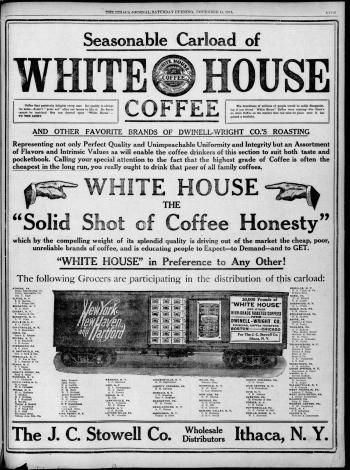
…
BROOKTON, N. Y
M. E. Mills
…
— 14 Nov 1914, The Ithaca Journal, Ithaca NY, p5, newspapers.com. View largest available size.
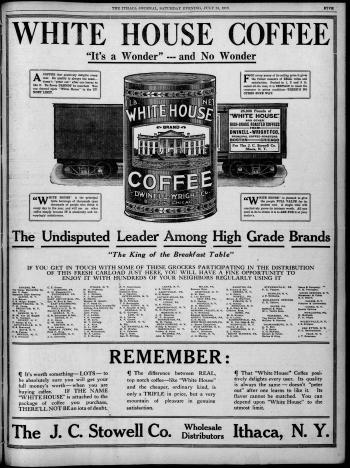
…
BROOKTON, N. Y
M. E. Mills
…
— 24 Jul 1915, The Ithaca Journal, Ithaca NY, p5, newspapers.com. View largest available size.

MARGARET LA BARRE will hold a sale of millinery goods at Miss Mills’ store, Brookton, April 10 and 24. 5-7
— 07 Apr 1915, The Ithaca Journal, Ithaca NY, p10, newspapers.com. View largest available size.
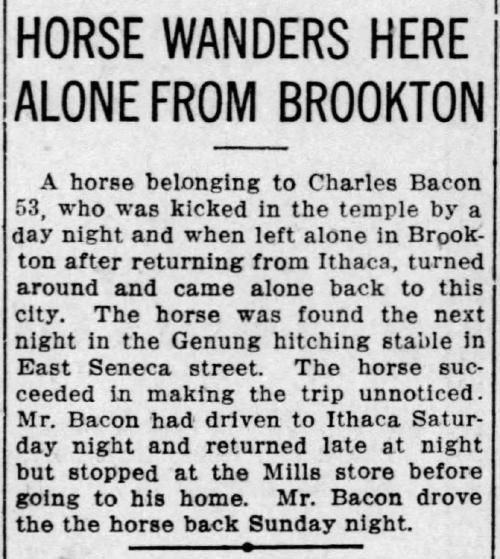
HORSE WANDERS HERE ALONE FROM BROOKTON
A horse belonging to Charles Bacon 53, who was kicked in the temple by a day night [sic] and when left alone in Brookton after returning from Ithaca, turned around and came alone back to this city. The horse was found the next night in the Genung hitching stable in East Seneca street. The horse succeeded in making the trip unnoticed. Mr. Bacon had driven to Ithaca Saturday night and returned late at night but stopped at the Mills store before going to his home. Mr. Bacon drove the horse back Sunday night.
— 08 Aug 1916, The Ithaca Journal, Ithaca NY, p3, newspapers.com. View largest available size.
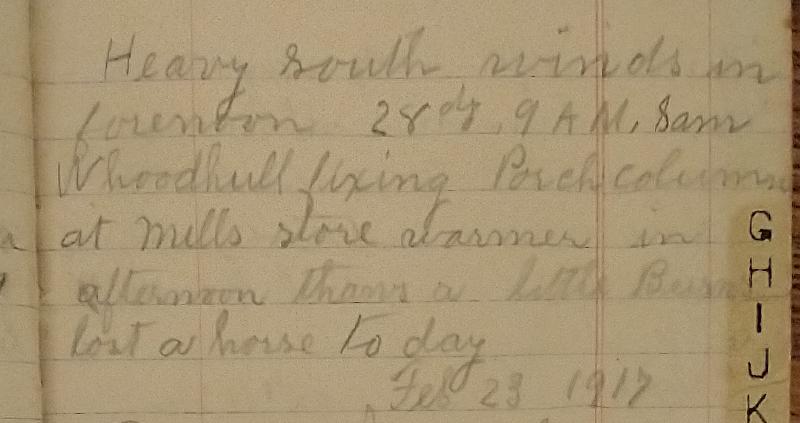
Heavy South winds in forenoon 28 dg, 9 AM. Sam Woodhull fixing Porch columns at Mills store warmer in afternoon thaws a little Burns lost a horse to day
Feb 23 1917
— Notebooks of George E. Jansen, Tompkins County History Center, Ithaca NY. View largest available size.
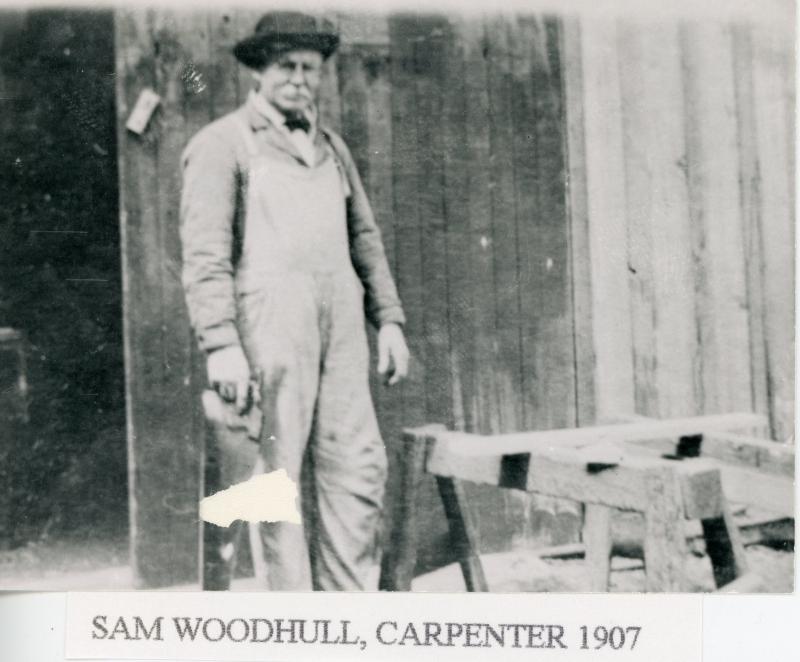
Sam Woodhull, Carpenter 1907
— Gertrude Conant Collection, Caroline History Room, Slaterville Springs NY. View largest available size.
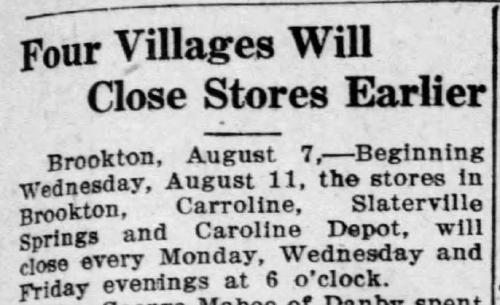
Four Villages Will Close Stores Earlier
Brookton, August 7,—Beginning Wednesday, August 11, the stores in Brookton, Carroline, Slaterville Springs and Caroline Depot, will close every Monday, Wednesday and Friday evenings at 6 o’clock.
— 07 Aug 1920, The Ithaca Journal, Ithaca NY, p7, newspapers.com. View largest available size.
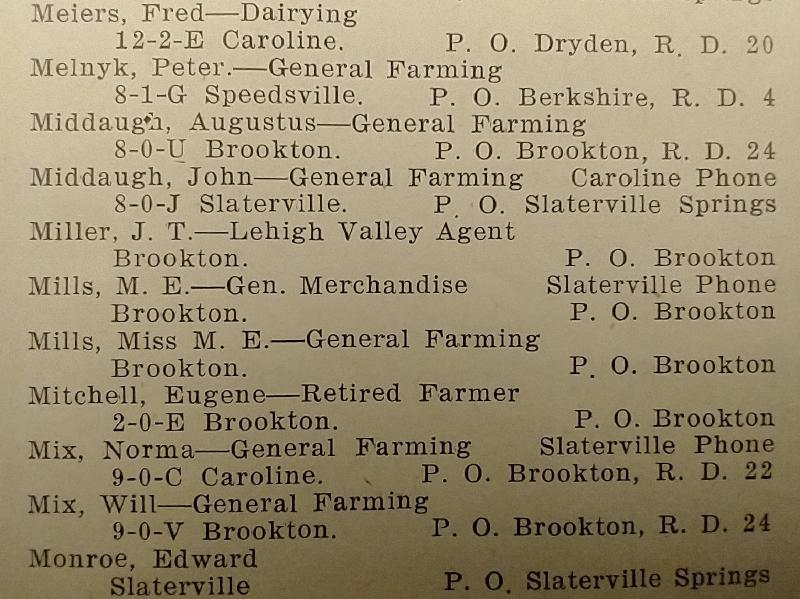
… Mills, M. E.—Gen. Merchandise Slaterville Phone
Brookton. P. O. Brookton
Mills, Miss M. E.—General Farming
Brookton. P. O. Brookton …
— 1920, “Clock System” Map and Farmer Directory, Tompkins County History Center, Ithaca NY. View largest available size.
Elizabeth “Libbie” H. (Sanders) Peck (05 Nov 1857 to 04 Nov 1929) took over ownership of the Mills’ store building upon the death of her sister Amanda (Sanders) Lounsbery (12 Oct 1842 to 13 Nov 1921).
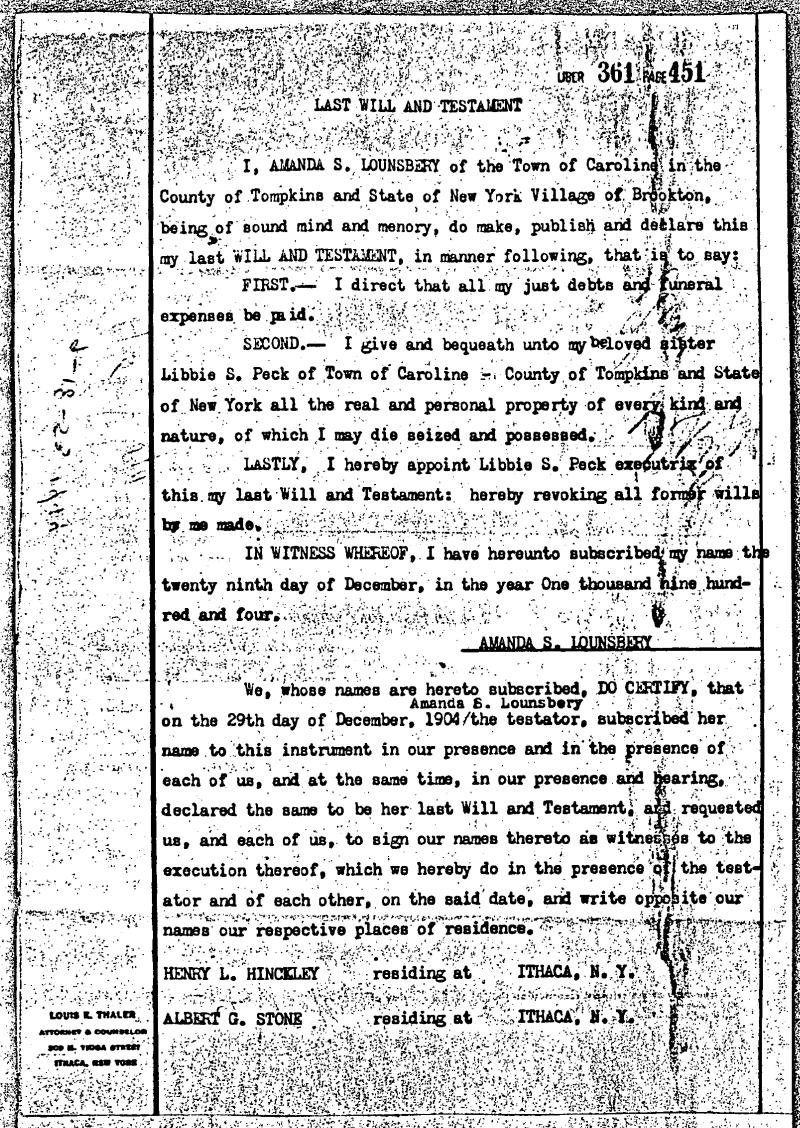
— 29 Dec 1904, Last Will and Testament of Amanda S. Lounsbery, Deeds 361, p451, Tompkins County Clerk, Ithaca NY. View largest available size.
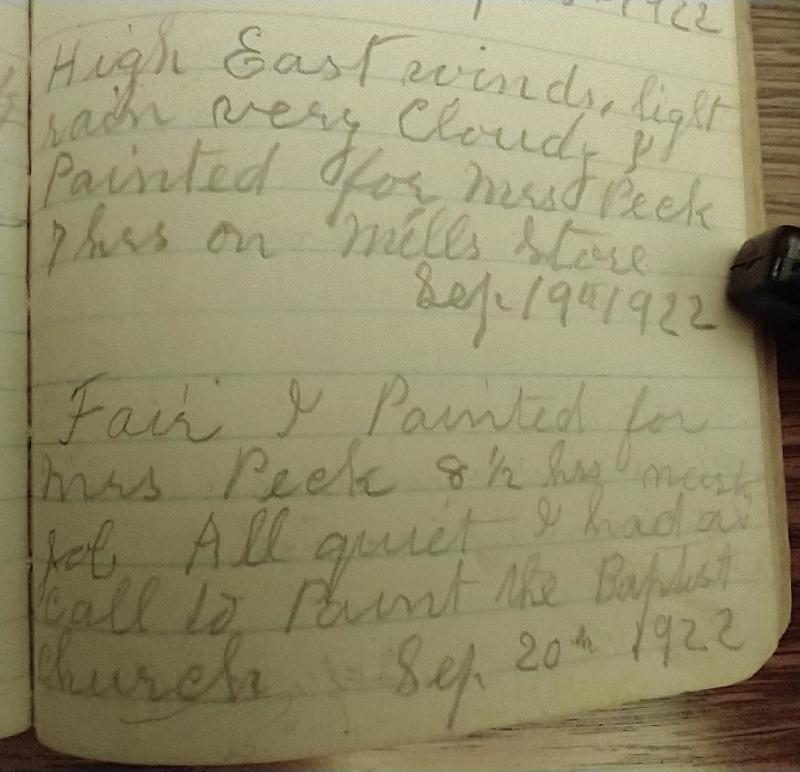
High East winds, light rain very cloudy I Painted for Mrs Peck 7 hrs on Mills Store
Sep 19th 1922
Fair I Painted for Mrs Peck 8 1/2 hrs nasty job All quiet I had a call to paint the Baptist Church
Sep 20th 1922
— Notebooks of George E. Jansen, Tompkins County History Center, Ithaca NY. View largest available size.
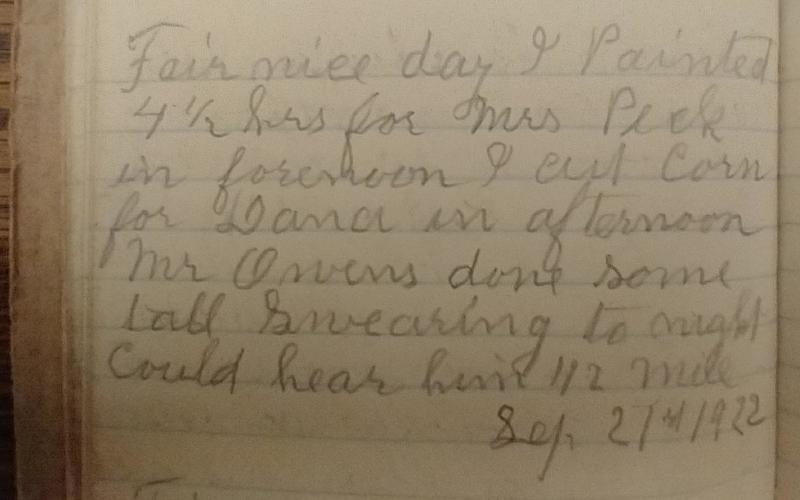
Fair nice day I Painted 4 1/2 hrs for Mrs Peck in forenoon I cut corn for Dana in afternoon Mr Owens done some tall swearing to night could hear him 1/2 mile
Sep 21st 1922
— Notebooks of George E. Jansen, Tompkins County History Center, Ithaca NY. View largest available size.
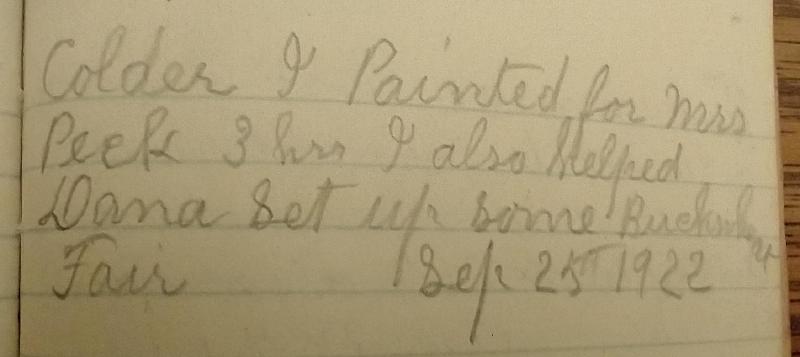
Colder I painted for Mrs Peck 3 hrs I also helped Data set up some Buckwheat Fair
Sep 25th 1922
— Notebooks of George E. Jansen, Tompkins County History Center, Ithaca NY. View largest available size.
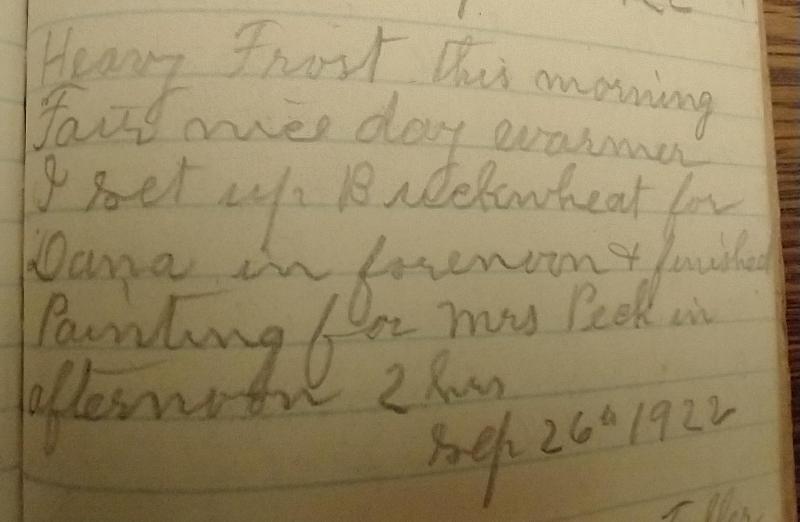
Heavy Frost this morning Fair nice day warmer I set up Buckwheat for Dana in forenoon & finished Painting for Mrs. Peck in afternoon 2 hrs
Sep 26th 1922
— Notebooks of George E. Jansen, Tompkins County History Center, Ithaca NY. View largest available size.

Mrs Geo Peck hrs Sep 19th 7 20th 8 1/2 21st 4 1/2 25th 3 26th 2 Paid
— Notebooks of George E. Jansen, Tompkins County History Center, Ithaca NY. View largest available size.
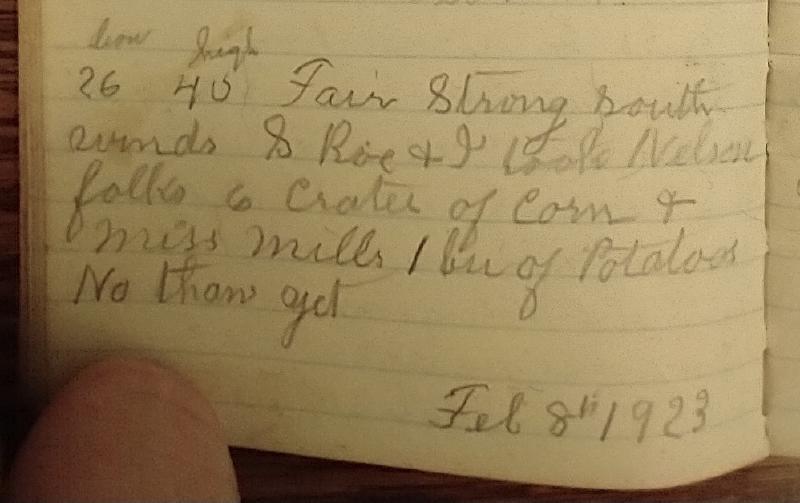
26 low 40 high Fair strong south winds S Roe & I took Nelson folks 6 crates of corn & Miss Mills 1 bin of Potatoes No thaw yet
Feb 8th 1923
— Notebooks of George E. Jansen, Tompkins County History Center, Ithaca NY. View largest available size.
In 1925, Libbie Peck sells the Mills’ store property to Dr. Benjamin Franklin Lockwood (01 Mar 1862 to 15 May 1934).
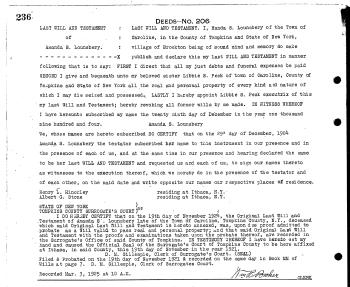
— 19 Nov 1924, Last Will and Testament of Amanda S. Lounsbery, Deeds 206, p236, Tompkins County Clerk, Ithaca NY. View largest available size.
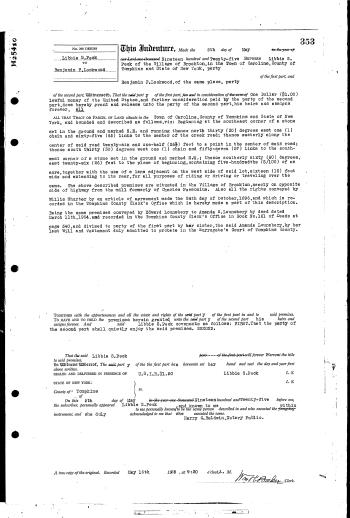
— 05 May 1925, Libbie S. Peck to Benjamin F. Lockwood, Deeds 208, p353, Tompkins County Clerk, Ithaca NY. View largest available size.
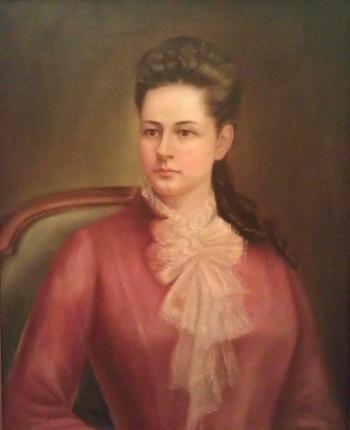
— Libbie Peck. From a family collection uploaded to Ancestry.com by J. Burbank, reproduced here with permission, Identity confirmed by J. Burbank, personal correspondence. View largest available size.
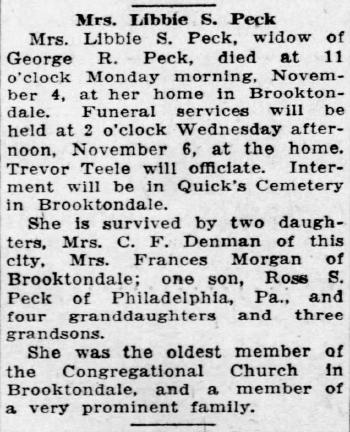
Mrs. Libbie S. Peck
Mrs. Libbie S. Peck, widow of George R. Peck, died at 11 o’clock Monday morning, November 4, at her home in Brooktondale. Funeral services will be held at 2 o’clock Wednesday afternoon, November 6, at the home. Trevor Teele will officiate. Interment will be in Quick’s Cemetery in Brooktondale.
She is survived by two daughters, Mrs. C. F. Denman of this city, Mrs. Frances Morgan of Brooktondale; one son, Ross S. Peck of Philadelphia, Pa. and four granddaughters and three grandsons.
She was the oldest member of the Congregational Church in Brooktondale, and a member of a very prominent family.
— 05 Nov 1929, Ithaca Journal, Ithaca NY, p5, newspapers.com. View largest available size.
Although I have only had limited access to the Mills’ store journals–and therefore cannot claim to have reviewed them carefully or completely–I do not recall ever seeing expenses for leasing the Mills store space. While most of the business expenses in the journals are understandably for inventory, many other types of business expenses are also recorded there. Perhaps payment was on a longer schedule and I simply didn’t see the entries.
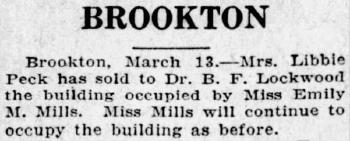
BROOKTON
Brookton, March 13.—Mrs. Libbie Peck has sold to Dr. B. F. Lockwood the building occupied by Miss Emily M. Mills. Miss Mills will continue to occupy the building as before.
— 13 Mar 1925, The Ithaca Journal, Ithaca NY, p12, newspapers.com. View largest available size.

Brooktondale, April 7.—Dr. B. F. Lockwood, who is repairing the interior of his home, is living over the M. E. Mills store while the work is being done.
— 07 Apr 1926, The Ithaca Journal, Ithaca NY, p14, newspapers.com. View largest available size.
Shortly after Dr. Lockwood’s death in 1934, his widow Mittie A. (Peer) Lockwood (10 Nov 1863 to 11 Oct 1939) sold the property to Jessie Brewer, days before Mills’ store was burglarized.
Two articles in the 14 Jul 1934 (p3) and 20 Nov 1934 (p5) issues of The Ithaca Journal tell of $135 in cash being stolen from M. E. Mills while Emily “was at lunch.” Despite the information being publicly available, I have chosen not to republish it here out of respect to any descendants of those accused.

Oct. 29—Brooktondale—Halloween party for Home Bureau members and families, in rooms above Miss Mills’ store, 8 p. m.
— 25 Oct 1935, The Ithaca Journal, Ithaca NY, p17, newspapers.com. View largest available size.
Identical notices for the Halloween party ran in The Ithaca Journal on 28 Oct and 29 Oct 1935.
And in the following, Molly Adams seems to indicate “at the store” refers to what is presently known as Brookton’s Market, owned by Robert (Bob) Tucker at that time, and not M. E. Mills, although her choice of words is noticeably vague on the point. Presumably, I can find the original quote and get a better sense of this, but it’s not obvious this isn’t referring to Mills’ store:
...At Old Home Day in 1935 Professor Edwin Shurter proposed a memorial to Dr. Lockwood: those who wished to contribute could sign up "at the store." This store in the center of town, with the post office attached, had become, and remains, a village hub.
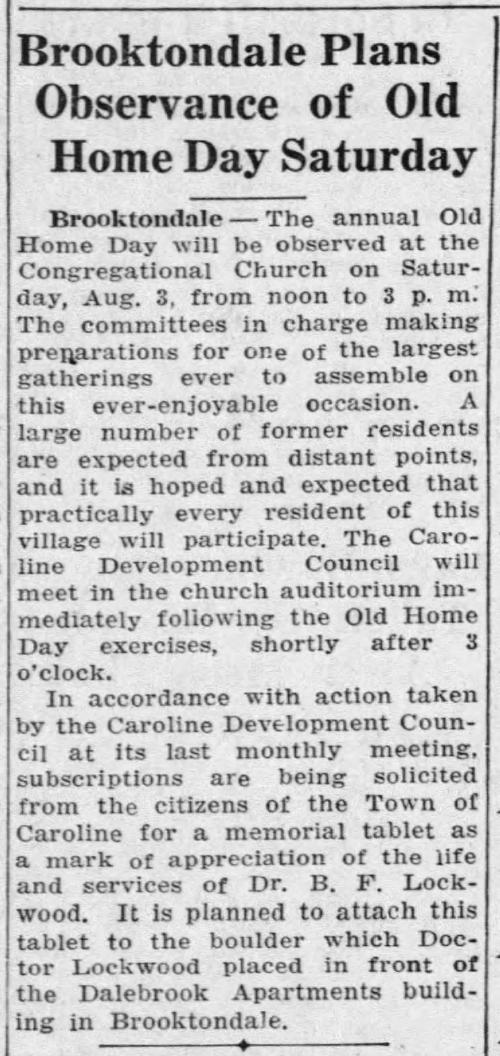
(Partial transcription.)
In accordance with action taken by the Caroline Development Council at its last monthly meeting, subscriptions are being solicited from the citizens of the Town of Caroline for a memorial tablet as a mark of appreciation of the life and services of Dr. B. F. Lockwood. It is planned to attach this tablet to the boulder which Doctor Lockwood placed in front of the Dalebrook Apartments building in Brooktondale.
— 31 Jul 1935, The Ithaca Journal, Ithaca NY, p14, newspapers.com. View largest available size.
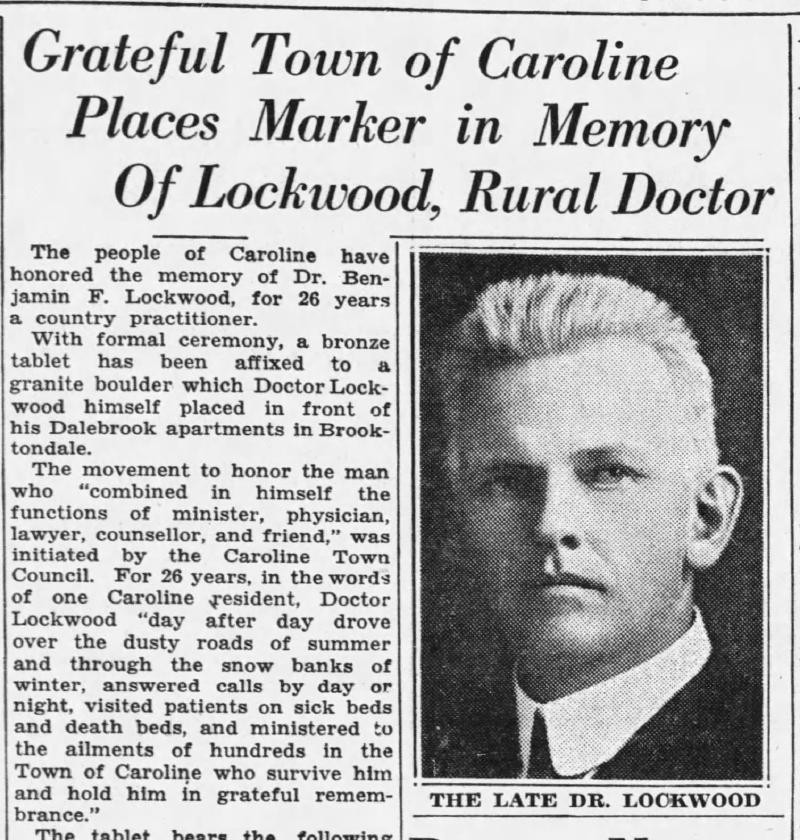
Grateful Town of Caroline Places Marker in Memory of Lockwood, Rural Doctor
The people of Caroline have honored the memory of Dr. Benjamin F. Lockwood, for 26 years a country practitioner.
With formal ceremony, a bronze tablet has been affixed to a granite boulder which Doctor Lockwood himself placed in front of his Dalebrook apartments in Brooktondale.
The movement to honor the man who “combined in himself the functions of minister, physician, lawyer, counsellor and friend,” was initiated by the Caroline Town Council. For 26 years, in the words of one Caroline resident, Doctor Lockwood “day after day drove over the dusty roads of summer and through the snow banks of winter, answered calls by day or night, visited patients on sick beds and death beds, and ministered to the ailments of hundreds in the Town of Caroline who survive him and hold him in grateful remembrance.”
The tablet bears the following inscription:
Dr. BENJAMIN F. LOCKWOOD
(1862-1934)
In grateful appreciation of his faithful services during a period of twenty-six years to the people of the Town of Caroline.
Among those who contributed to the tablet were:
From Brooktondale — Mr. and Mrs. Charles C. Stanley, Mike Snow, Robert J. Albertson, Mr. and Mrs. F. H. Atwater, Mr. and Mrs. P. J. Caveney, Charles Caveney, M. E. Mills, Roland Milhauser, Mr. and Mrs. C. M. Mulks, Mr. and Mrs. E. D. Shurter, Mr. and Mrs. H. J. Shurter, Mr. and Mrs. George Panco, Mr. and Mrs. Floyd Whitely, Mr. and Mrs. Lewis Brewer, Mr. and Mrs. Jesse E. Wrench, Mr. and Mrs. Kenneth Post, Mr. and Mrs. Morris Pratt, Dr. Mary Ridgway, Edith L. Thomas, Susie W. Lawrence, Mr. and Mrs. C. P. Lounsbery, Mr. and Mrs. Francis Wallace, Mr. and Mrs. Roland Brill, Mrs. Fannie Morgan, Mr. and Mrs. Lovell E. Preston, Mr. and Mrs. Charles Vandemark, Flora Root, Mr. and Mrs. Harry Vandemark, Herbert Whittaker, Leon Skinner, Mr. and Mrs. Gorton, Mr and Mrs. Ray Woodin, Mr. and Mrs. Lamont C. Snow.
Also, J. M. White, Clarence Wheeler, Bert McMaster, Mr. and Mrs. H. C. Whitlock, Harriet E. Snow, Kate Winchell, D. B. Bull, Etta Bishop, Sarah L. Mandeville, W. G. Besemer, Margaret Jewell, Evelyn B. Payne, Mr. and Mrs Benjamin Rightmyer, Elmer German, James F. Johns, Mr. and Mrs. Charles Munson, Bertha Beard, Grace Quick, Mrs. Cora Roe, Mrs. H. A. Davis, Mr. and Mrs. Walter Vandemark, Mrs. Sara Higgins, Mrs. Lira Sweetland, Eugene Williams, Charles Thomas, Wilson Westfall, Neena Wattles, Mrs A. E. Davenport, Mr. and Mrs. H. W. Butts, Mr. and Mrs. D. B. Martin, Mrs. Elsie Sherwood, Ruth Selover, Vernon Switzer, Mrs. D. F. McWhorter.
From Slaterville Springs — Mrs. Sue C. Earsley, Mr. and Mrs J. W. Page, Mr. and Mrs. D. A. Chatfield, Lyman Gallager, R. H. Wool.
From Ithaca — Fred Gilbert, F. D. Herholdt, Dr. Norman S. Moore, Dr. R. M. Vose and Mrs. Vose.
— 23 Nov 1935, The Ithaca Journal, Ithaca NY, p5, newspapers.com. View largest available size.
The memorial, presumably with the text provided by the professor, currently sits outside of Dalebrook Apartments, near the southwest corner of the structure, directly across the street from the former location of Mills’ store, and facing the former Lockwood residence. There is also a bronze sundial on top of the stone (not visible in the photo) that appears to have been attached along with the tablet.
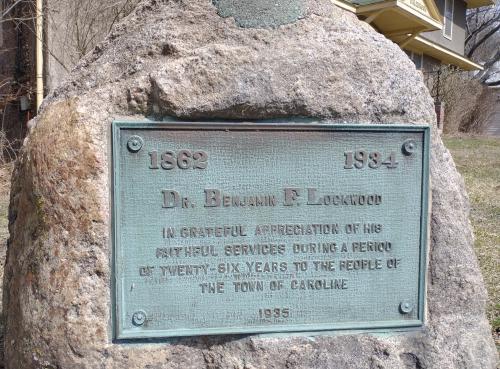

June 24—Brooktondale—Meeting of Congregational Church Ladies Aid in hall over Miss Mills’ store to tie quilt.
— 20 Jun 1936, The Ithaca Journal, Ithaca NY, p9, newspapers.com. View largest available size.
As noted in other histories, Jessie Brewer took over the store at the same location, running it under her name primarily as a notions store with a lending library in the back, but unlike Mills’, Jessie Brewer did not carry groceries.
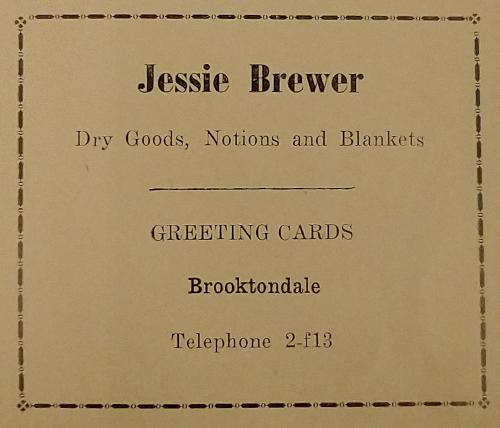
— 01 Dec 1944, Caroline Farmers Telephone Company, Tompkins County History Center, Ithaca NY. View largest available size.
Jessie Brewer ran a dry goods store in Brooktondale, selling fabric, ribbon, greeting cards, and other items. She took it over from a woman who had managed a grocery store in the same building and used the proceeds from the store to increase the family income and help support her widowed [step-]mother. She was also active in the Caroline Valley Federated (now Community) Church.

GOING OUT OF BUSINESS SALE—Notions, prints, cosmetics, etc. Reduction on all goods. Jessie Brewer, Prop., Brooktondale, N.Y.
— 11 May 1950, The Ithaca Journal, Ithaca NY, p27, newspapers.com. View largest available size.
The Brooktondale post office, which had expanded operations when Caroline Depot closed in 1952 (and which now serves all of Caroline except Slaterville village and Speedsville), moved across the street when Jessie Brewer closed her store.
1961, Postmaster Charles Vorhis bought Jessie Brewer's store and moved the post office across the street. This store had been Mr. Mills dry goods store and was carried on for thirty years after his death by his daughter Emily Mills, who carried kerosene, kerosene lamps with green shades, penny candy, stockings, handkerchiefs, yard goods, pins and sewing notions, sheets and pillowcases. Emily Mills died in 1937. Jessie Brewer, who grew up in the house next door as Jessie Shurter, kept a dry goods store here after Miss Mills and had a lending library in the back of the store. (The Shurter House, which sat between the post office and the bridge, was moved to 447 Brooktondale Road in 1964 when the road was improved.)
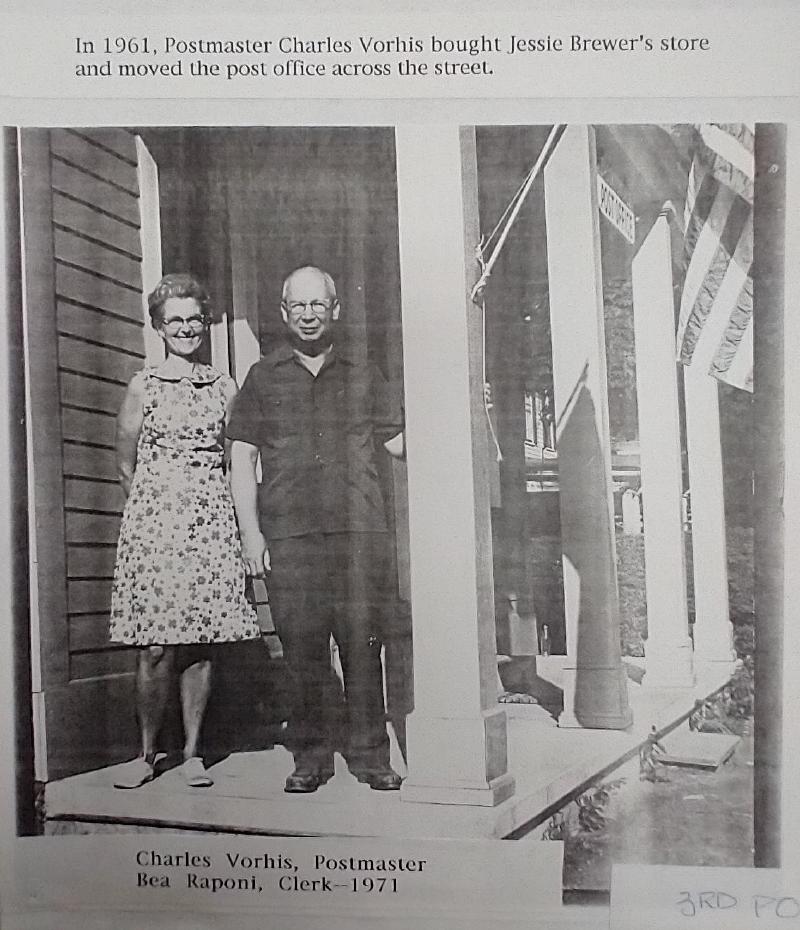
In 1961, Postmaster Charles Vorhis bought Jessie Brewer’s store and moved the post office across the street.
Charles Vorhis, Postmaster
Bea Raponi, Clerk - 1971
3rd PO
— Digital photograph of print photograph from the Molly Adams Collection. View largest available size.
Bea Raponi may be the last living person with first-hand memories of Emily and her store. She told me that enough time has passed that she doesn’t believe she could identify Emily in photos. I invited her to write down anything about Emily she does remember and send it to me for inclusion with these materials.
03 Aug 2022, Frank Proto offered to let me look around Mills’ store building, which I had only been inside once prior. At this time, only a small space downstairs was used by Frank as an office, while the upstairs was an apartment, although it was unrented at the time.
Frank mentioned that he had removed the old linoleum flooring from the time of the Vorhis post-office, exposing the hardwood beneath. The antique metal ceiling was also added.
There are potentially artifacts from the time of Mills’ store in the building. There are a number of items that predate Vorhis’ ownership, including old wooden mailboxes that may have been used when Edward was postmaster. There are also old wooden boxes with food brands painted on them.
The basement is accessed from a door that opens in the floor. This door is near a large exterior door where deliveries were likely made. The basement floor is fine dirt.
Frank speculates that the upstairs rear room may have been used for masonic meetings, and pointed out that an interior door contained a large peep-hole.
Mills’ store is easily visible from most windows in most rooms of Mills’ Home.
The Brewer Barn
The Mills’ home is the only real estate that I can find official documentation for the Mills’ owning in Tompkins County. Yet in the sales journals of E. H. Mills general store in Brookton, the inside front cover of volume 41 indicates the purchase of a barn on 23 Sep 1907 that was rented to John Roe for $0.50 a month starting in 1908:
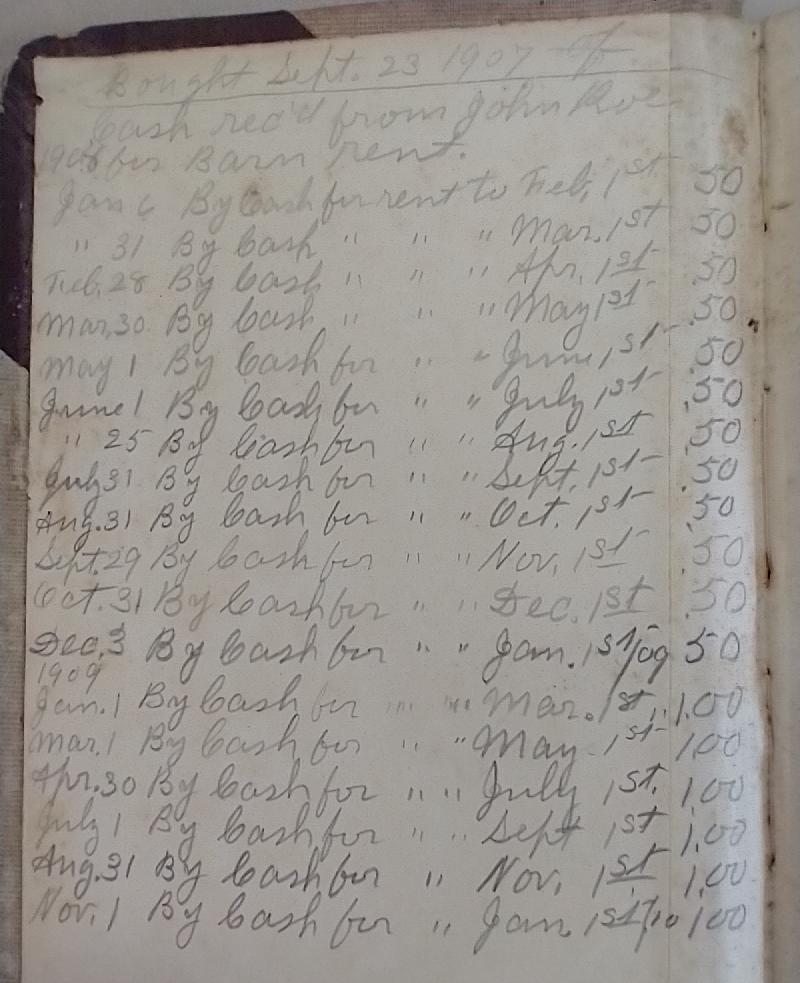
— 23 Sep 1907, E. H. Mills Store Sales Journal No. 41, inside front cover, digital photograph of book owned by Brooktondale collector. View largest available size.
There was a barn on the Mills’ home property at one time, but by 1907, it was on land owned by the Mills since they purchased the property from Edward and Amanda Lounsbery 05 Jan 1903 (Deeds 157, p593):

— 26 Feb 1912, Plans for Improving the Cooks Corners-Brookton: Slaterville Springs-Caroline County Highway, Instrument number BF033282-001, Sheet 5, Tompkins County Clerk, Ithaca NY. Cropped. View largest available size.
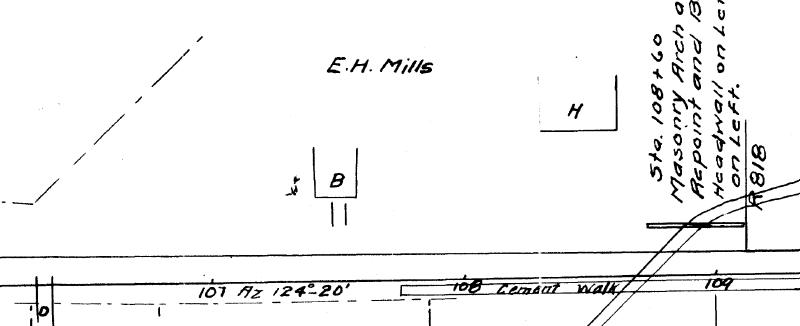
— 26 Feb 1912, Plans for Improving the Cooks Corners-Brookton: Slaterville Springs-Caroline County Highway, Instrument number BF033282-001, Sheet 5, Tompkins County Clerk, Ithaca NY. Cropped. View largest available size.
There is only one other deed I have found associated with the Mills’ family, and it was a transaction that Emily helped facilitate between Willis Shurter and his wife Betsey:
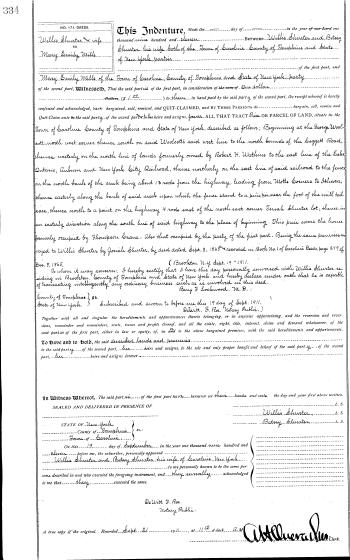
— 19 Sep 1911, Willis Shurter and Betsey Shurter to Mary Emily Mills, Deeds 171, p334, Tompkins County Clerk, Ithaca NY. View largest available size.
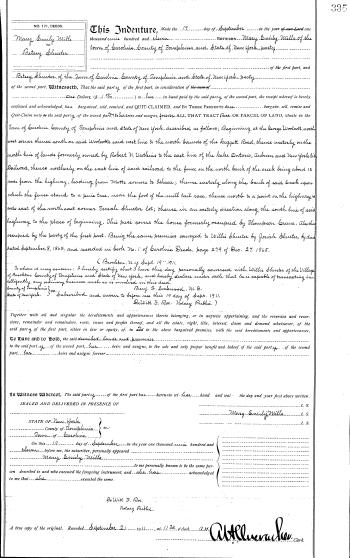
— 19 Sep 1911, Mary Emily Mills to Betsey Shurter, Deeds 171, p335, Tompkins County Clerk, Ithaca NY. View largest available size.
Notice that these deeds include an affidavit from Dr. Lockwood.
I have searched both 1907 and 1908 deed books, for both Caroline and Danby, for the following names: Lounsbery, Lockwood, Mills, Mulks, Roe, Reid and Shurter, and I have not found a deed that corresponds to this date or that explicitly describes a barn. Interestingly, there is a real estate transaction between Amanda Lounsbery and John Roe earlier in 1907, that is perhaps related to the barn rental:
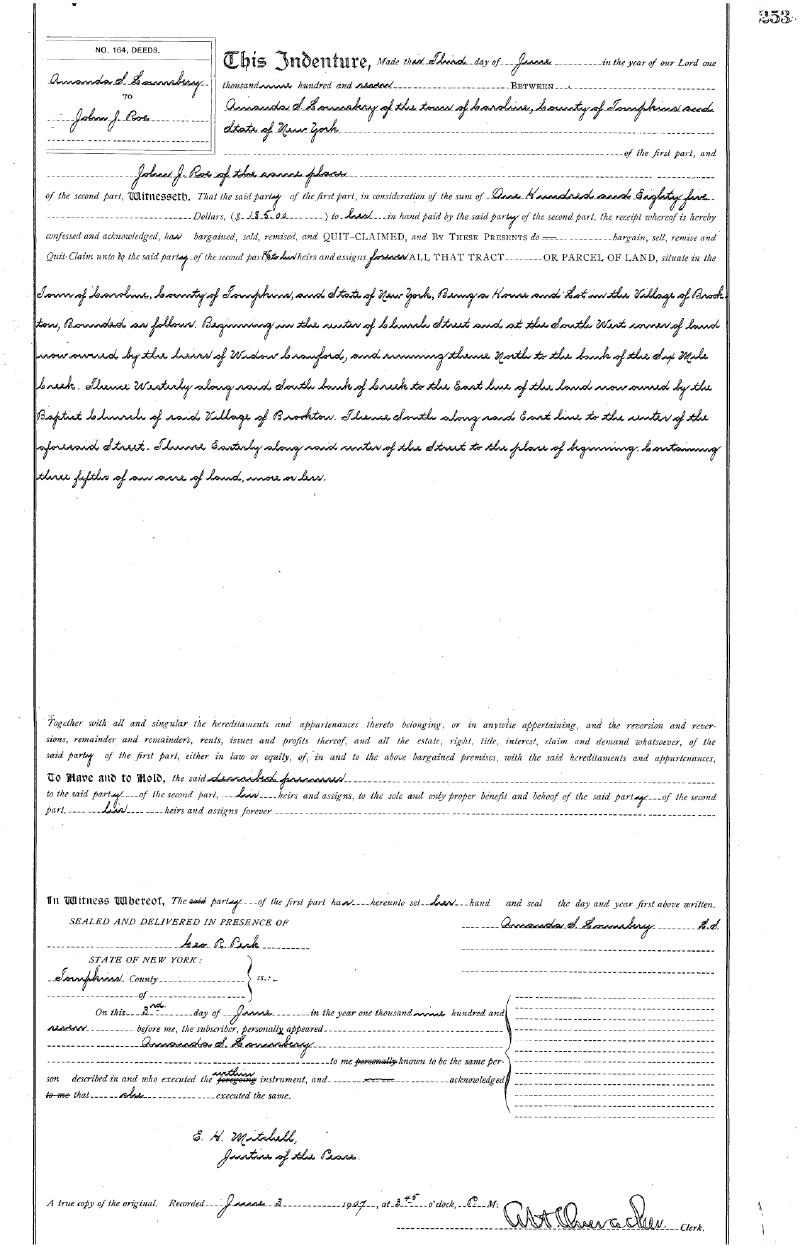
— 03 Jun 1907, Amanda Lounsbery to John J. Roe, Deeds 164, p253, Tompkins County Clerk, Ithaca NY. View largest available size.
Perhaps the purchase indicated was not by the Mills, but by Edward and Amanda Lounsbery, or possibly Jessie Shurter, and the Mills were providing a service on behalf of the barn owner , to collect and account for these transactions at a convenient existing business already frequented by community members.
Note in the survey maps below, the existence of a structure labeled “Brewer Barn”, at the rear of the Lockwood property and behind the Mulks and Lockwood barns, that may be the barn in question. A note indicates that “Brewer uses this driveway by permit”. Jessie Brewer owned the store at that time and the driveway leads from the store to the barn.
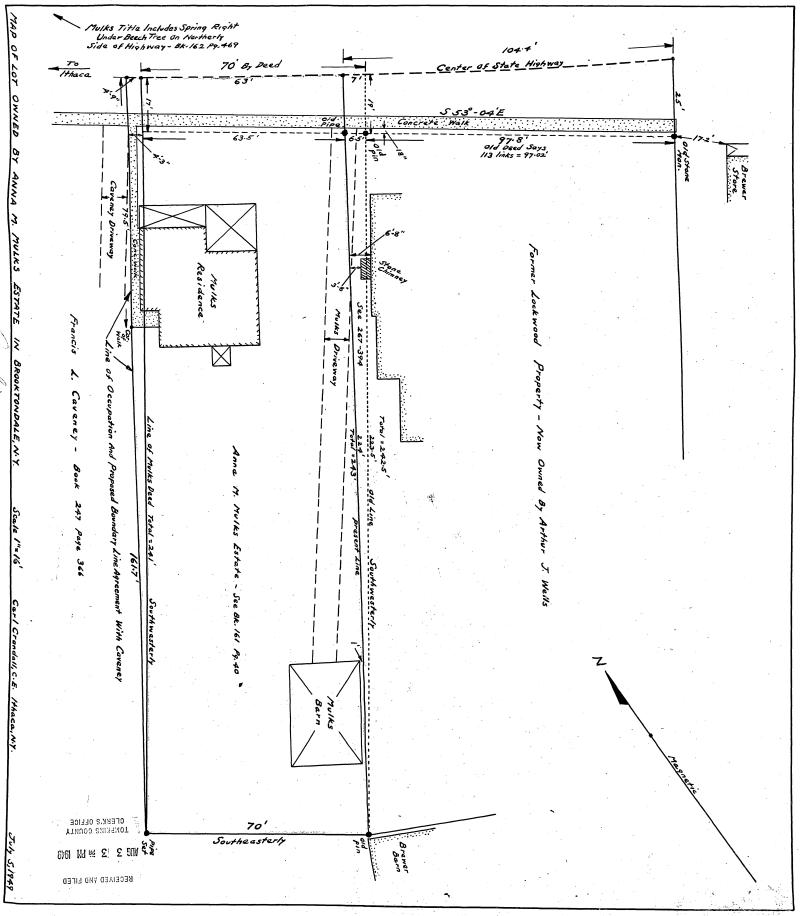
— 05 Jul 1949, Maps Book A1, p16, Tompkins County Clerk, Ithaca NY. Rotated clockwise 90 degrees.View largest available size.
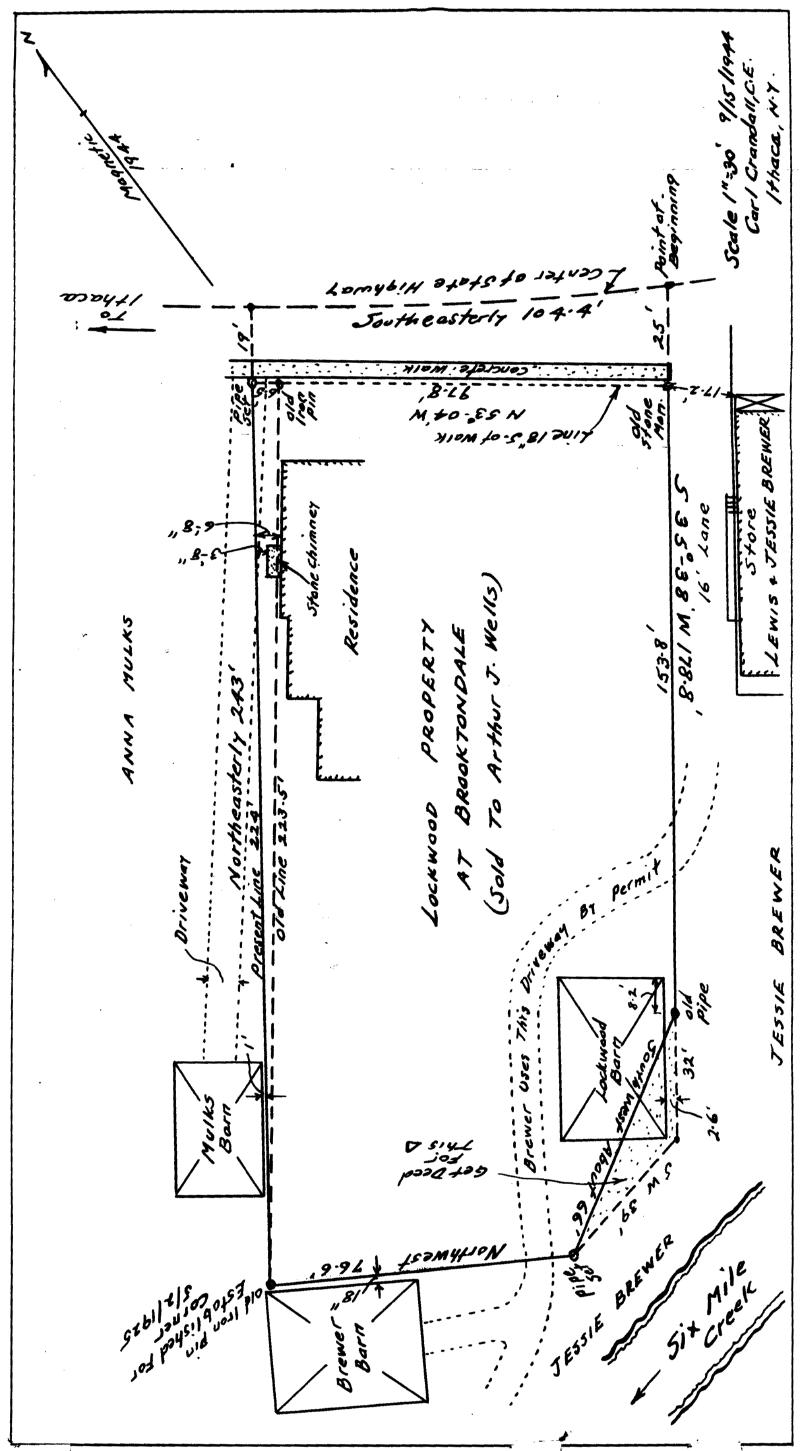
— 1944 Sep 15, Deeds 272, p322, Instrument Number BF127082-001, Tompkins County Clerk, Ithaca NY. View largest available size.
The documentary evidence indicates that the Brewer Barn was “Willis Shurter’s Wagon Shop in Motts Corners”.
In the description of the oldest deed for Mulks’s Home at present day 478 Brooktondale Road that I have yet found, from 04 Jun 1870, Caroline Deeds 3, p181, Jacob Vandemark, Charles W. Personeus & Marcie E. his wife to Jacob Vandemark, it states that the property begins “in the center of the ‘Creek Road’ and 113 links westerly from a line with the west side of Willis Shurter’s Wagon Shop in Motts Corners…” This description is repeated in the next transfer on 27 Nov 1889 (Deeds 135/113), and only in the next transfer on 22 Oct 1896 (Deeds 146, p481) does the description change to “…what was formerly known as Willis Shurter’s Wagon Shop in Motts Corners…” (emphasis added).
The matching distance of 113 links indicated on Map A1, p16 shown above confirms that this describes the western edge of the “lane” between the Lockwood Residence at present-day 480 Brooktondale Road and the Mills’ Store structure. This “lane” and the “Brewer Barn” were always conveyed with the store lot until 11 Jun 1963, when Jessie Brewer transfers both the “lane” and the barn to Arthur and Dorothy Wells, at which point, they became part of the Lockwood Residence lot, and they remain so as I write this. This also explains why the stairway to the second floor (Lounsbery Hall) of Mills’ Store, on the western side of the building, has since that time encroached onto the Lockwood lot.
Willis Shurter inherited his father Josiah’s properties, including the Shurter House and the lower grist mill. Josiah Shurter is listed in the census as a “wagon maker” (1870) and in 1875 both he and son-in-law William Benton Wolcott share the occupation “carriage maker”.
| Year | Josiah Shurter | Willis Shurter | John Wolcott | William B. Wolcott | George Wolcott |
|---|---|---|---|---|---|
| 1850 | farmer | (child) | carpenter | carpenter | (child) |
| 1860 | farmer | farmer | carpenter | carpenter | clerk |
| 1865 | miller | ns | carpenter | carpenter | merchant |
| 1870 | wagon maker | farmer | carpenter | wagon maker | carpenter |
| 1875 | carriage maker | nf | carpenter | carriage maker | farmer |
| 1880 | dec | farmer | farmer | wagon maker | farmer |
| 1892 | dec | farmer | farmer | carpenter | farmer |
– Occupations, United States Federal Census and New York State Census, Caroline NY, ancestry.com.
Immediately after mustering out of the Union Army, William is living with his wife Ellen, her father Josiah, and her brother Willis.

— 26 Jun 1865, New York State Census, Town of Caroline, p34, ancestry.com. View largest available size.
Therefore, it seems reasonable to assume that William Benton Wolcott worked for his father-in-law and/or brother-in-law at some point, and that this work was in the Brewer Barn. Josiah’s son Willis inherited his father’s properties and business interests by the late 1860’s, and the store property was eventually purchased by Willis’ and Betsey’s daughter Jessie Brewer.
(Willis Shurter’s first wife, identified as “Jane” in the store deeds, was Mary Jane “Jennie” (German) Shurter (1845 to 12 Mar 1872). It is Willis Shurter’s second wife Betsey Alvira “Betty” (Merrill) Shurter (1847 to 04 Jul 1932), whom he married in 1876, who is the mother of Jessie M. (Shurter) Brewer (27 Jun 1881 to 16 Sep 1974).)
Willis Shurter was a Civil War veteran who had “been an invalid a number of years” (15 Jan 1914, The Ithaca Journal, Ithaca NY, p9, newspapers.com).
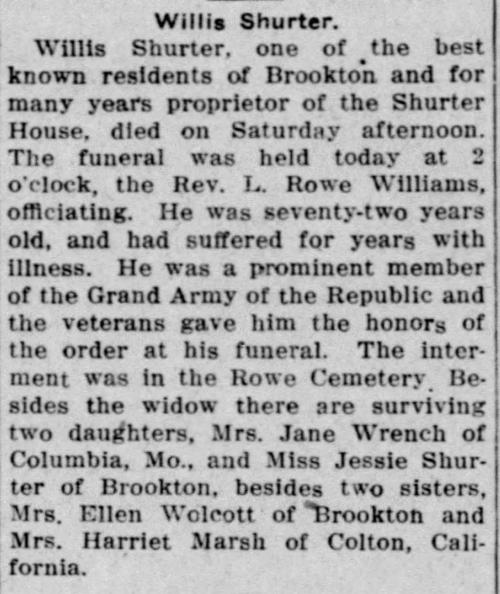
Willis Shurter.
Willis Shurter, one of the best known residents of Brookton and for many years proprietor of the Shurter House, died on Saturday afternoon. The funeral was held today at 2 o’clock, the Rev. L. Rowe Williams, officiating. He was seventy-two years old, and had suffered for years with illness. He was a prominent member of the Grand Army of the Republic and the veterans gave him the honors of the order at his funeral. The interment was in the Rowe Cemetery. Besides the widow there are surviving two daughters, Mrs. Jane Wrench of Columbia, Mo., and Miss Jessie Shurter of Brookton, besides two sisters, Mrs. Ellen Wolcott of Brookton and Mrs. Harriet Marsh of Colton, California.
— 19 Jan 1914, The Ithaca Journal, Ithaca NY, p6, newspapers.com. View largest available size.
The Brewer Barn still exists as I write this, and in a conversation on 19 May 2023, Frank Proto told me that according to what he was told by Charles Vorhis many years ago: Jessie Brewer rented horses and carriages from this barn in the distant past.
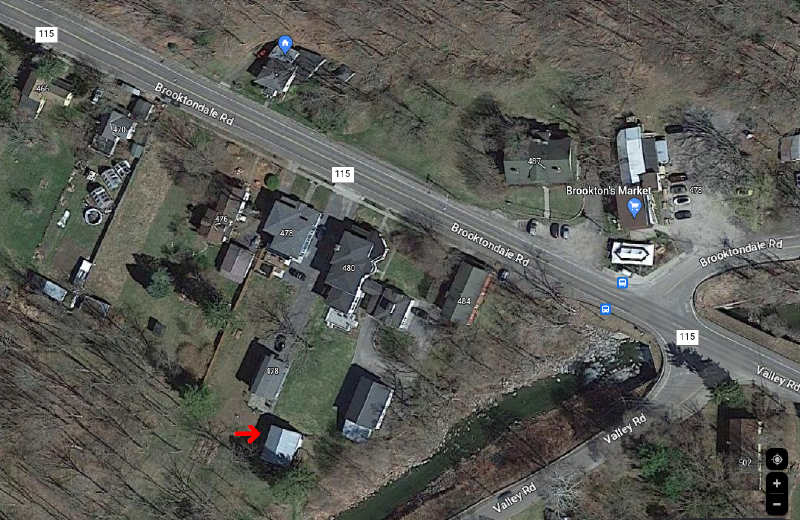
— Google Maps. View largest available size.

— 19 May 2023, Adam Smith. View largest available size.
- From left to right, the white home in the foreground is the Lockwood Residence; the raw wood barn in the background is the “Brewer Barn”; the blue barn in the background is “Mulk’s Barn” and the blue home in the foreground is Mulk’s Home.

— 22 May 2023, Adam Smith. View largest available size.
- Rear view of the Brewer Barn from Valley (Lower Depot) Road. Six Mile Creek is visible in the foreground.
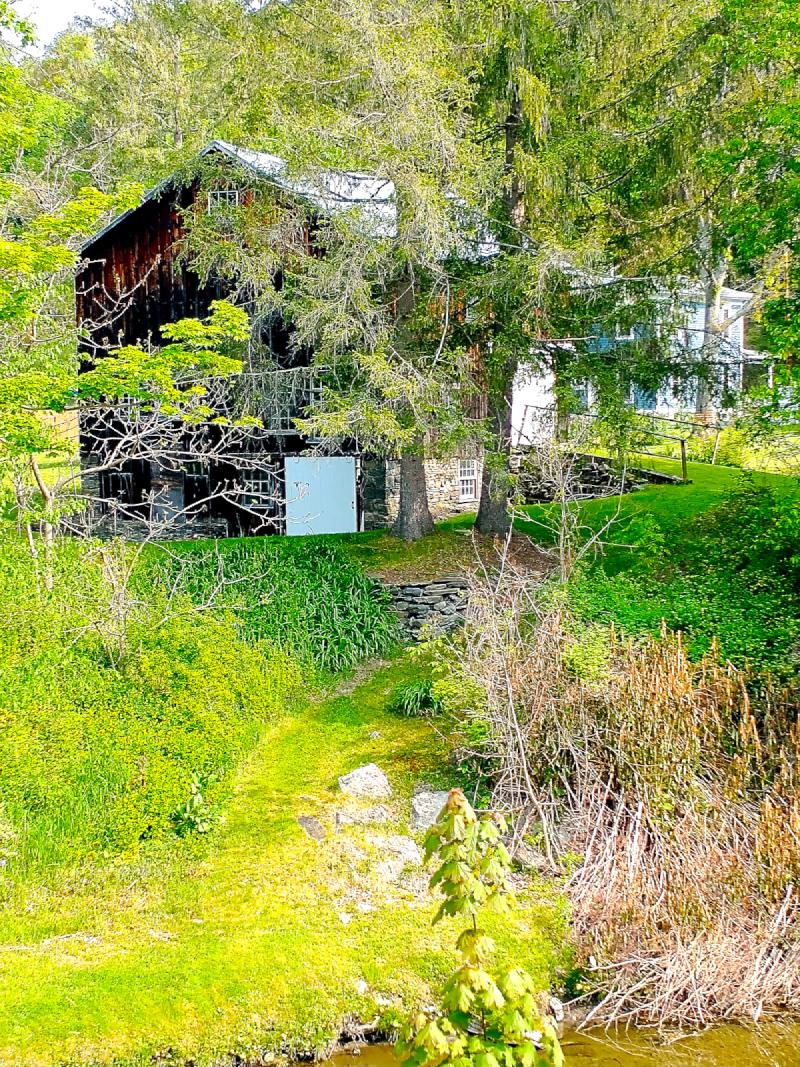
— 22 May 2023, Adam Smith. View largest available size.
- Rear view of the Brewer Barn from Valley (Lower Depot) Road. Six Mile Creek is visible in the foreground. Mulk’s Home is visible in the background.
Notes for Future Researchers
In the Caroline History Room in Slaterville Springs, there are a set of similar looking general store sales journals that appear to belong to Mulk’s general store which was in the same location as Brookton’s Market today.
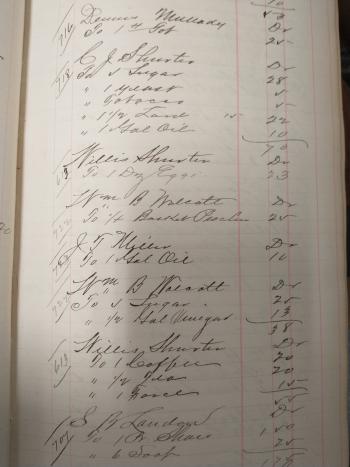
— 2021 photograph of presumed Vorhis store journals taken at Caroline History Room, Slaterville Springs NY. View largest available size.
- (In the Brookton’s Market 2011 Calendar, Willis Shurter is identified as the first man sitting on the left in a famous photo of Frank F. Mulks that is also used for the cover image of “Around Caroline” by Partricia A. Brhel, 2016.)
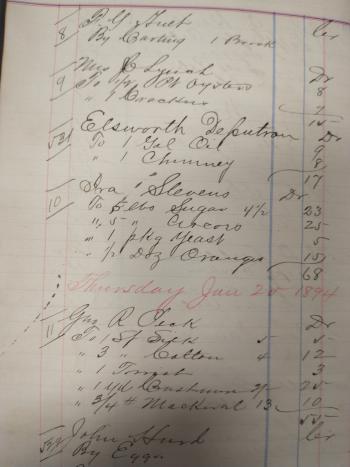
— 2021 photograph of presumed Vorhis store journals taken at Caroline History Room, Slaterville Springs NY. View largest available size.
Notice the familiar names: William B. Wolcott, Willis Shurter, George R. Peck, and Jerome Miller, the station agent at Brookton Depot.
These volumes are leather bound, but with badly deteriorating covers, containing entries from the 1890’s to the early 190X’s. I could not find anything in the volumes themselves directly identifying the store these journals were for, but I only reviewed the books briefly. A note accompanying them indicated they were donated by Frank Proto, owner of both Dalebrook and the Mills’ store location at the time of this writing.
Given that Frank donated them, and that the style of record keeping is quite similar to known Mills sales journals, I initially hoped these might be earlier books of E. H. Mills’ general store. When asked for more information on their origin, Barbara Kone said they came from Frank’s basement, and when pressed further for which basement, she said “from the Mill” meaning the basement of Dalebrook. In a later conversation with Frank Proto, he confirmed that he donated these volumes on “permanent loan” to the Caroline History Room, and that they came from the basement of Dalebrook, when Frank purchased the property from Charles Vorhis.
At the time of the sales journals in question, the general store next to Dalebrook was Frank F. Mulks general store, presently, Brookton’s Market, and it appears the prices used in the comparisons in the Brookton's Market 2011 Calendar came from these books, indicating that the calendar’s creators linked these books to Mulks’s store.
My review led me to conclude there were possibly several different handwriting styles, and although I have not looked through the entries thoroughly, I spent a little time reviewing a random sampling of entries over several books and based on my familiarity with Emily’s writing, I concluded that I did not find examples of it in these journals. Obviously a more careful examination should be done, but in the meantime, the weight of the evidence leads me to also conclude that these sales journals most likely came from Mulks’ store.